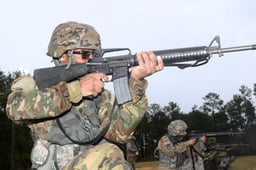M16 rifle

M16 rifle

| Rifle, Caliber 5.56 mm, M16 | |
|---|---|
| Type | Assault rifle |
| Place of origin | United States |
| Service history | |
| In service | 1964–present[1] |
| Used by | See Users |
| Wars | Vietnam War Indonesian confrontation Communist insurgency in Malaysia Laotian Civil War Cambodian Civil War Communist rebellion in the Philippines[2] Moro conflict[3] Insurgency in Aceh Shaba II[4] Cambodian–Vietnamese War Sino-Vietnamese War Salvadoran Civil War Lebanese Civil War Invasion of Grenada Sri Lankan Civil War Somali Civil War The Troubles First Liberian Civil War[5] Gulf War Sierra Leone Civil War[6] Nepalese Civil War Burundian Civil War First Congo War[7] Second Liberian Civil War War in Afghanistan Iraq War War in Darfur[8] Kivu conflict 2013 Lahad Datu standoff Iraqi Civil War (2014–2017)[9] Syrian Civil War[10] Battle of Marawi[11] |
| Production history | |
| Designer | Eugene Stoner and L. James Sullivan[12] |
| Designed | 1959[13] |
| Manufacturer |
|
| Produced |
|
| No. built | c. 8 million[14] |
| Variants | See List of Colt AR-15 and M16 rifle variants |
| Specifications (M16) | |
| Mass | 6.37 lb (2.89 kg) (unloaded) 7.5 lb (3.40 kg) (loaded) |
| Length | 39.5 in (1,003 mm) |
| Barrel length | 20 in (508 mm) |
| Cartridge | 5.56×45mm NATO (M193) |
| Caliber | 5.56 mm |
| Action | Gas-operated, rotating bolt (direct impingement) |
| Rate of fire | 700–950 rounds/min cyclic sustained 45–60 rounds/min semi-automatic |
| Muzzle velocity | 3,150 ft/s (960 m/s) (M855A1 round)[15] |
| Effective firing range | 550 m (601 yd) (point target)[16] 800 m (875 yd) (area target)[17] |
| Maximum firing range | 3,600 m (3,937 yd) |
| Feed system | STANAG magazine 20-round detachable box magazine: 0.211 lb (96 g) empty / 0.738 lb (335 g) full 30-round detachable box magazine: 0.257 lb (117 g) empty / 1.06 lb (480 g) full) Beta C-Mag 100-round double-lobed drum: 2.20 lb (1,000 g) empty / 4.81 lb (2,180 g) full) |
| Sights | Iron sights or various optics |
The M16 rifle, officially designated Rifle, Caliber 5.56 mm, M16, is a family of military rifles adapted from the ArmaLite AR-15 rifle for the United States military. The original M16 rifle was a 5.56mm automatic rifle with a 20-round magazine.
In 1964, the M16 entered US military service and the following year was deployed for jungle warfare operations during the Vietnam War.[1] In 1969, the M16A1 replaced the M14 rifle to become the US military's standard service rifle.[18][19] The M16A1 improvements include a bolt-assist, chrome-plated bore and a 30-round magazine.[1]
In 1983, the US Marine Corps adopted the M16A2 rifle and the US Army adopted it in 1986. The M16A2 fires the improved 5.56×45mm NATO (M855/SS109) cartridge and has a newer adjustable rear sight, case deflector, heavy barrel, improved handguard, pistol grip and buttstock, as well as a semi-auto and three-round burst fire selector.[20][21] Adopted in 1998, the M16A4 is the fourth generation of the M16 series.[22] It is equipped with a removable carrying handle and Picatinny rail for mounting optics and other ancillary devices.[22]
The M16 has also been widely adopted by other armed forces around the world. Total worldwide production of M16s has been approximately 8 million, making it the most-produced firearm of its 5.56 mm caliber.[23] The US military has largely replaced the M16 in frontline combat units with a shorter and lighter version, the M4 carbine.[24][25]
| Rifle, Caliber 5.56 mm, M16 | |
|---|---|
| Type | Assault rifle |
| Place of origin | United States |
| Service history | |
| In service | 1964–present[1] |
| Used by | See Users |
| Wars | Vietnam War Indonesian confrontation Communist insurgency in Malaysia Laotian Civil War Cambodian Civil War Communist rebellion in the Philippines[2] Moro conflict[3] Insurgency in Aceh Shaba II[4] Cambodian–Vietnamese War Sino-Vietnamese War Salvadoran Civil War Lebanese Civil War Invasion of Grenada Sri Lankan Civil War Somali Civil War The Troubles First Liberian Civil War[5] Gulf War Sierra Leone Civil War[6] Nepalese Civil War Burundian Civil War First Congo War[7] Second Liberian Civil War War in Afghanistan Iraq War War in Darfur[8] Kivu conflict 2013 Lahad Datu standoff Iraqi Civil War (2014–2017)[9] Syrian Civil War[10] Battle of Marawi[11] |
| Production history | |
| Designer | Eugene Stoner and L. James Sullivan[12] |
| Designed | 1959[13] |
| Manufacturer |
|
| Produced |
|
| No. built | c. 8 million[14] |
| Variants | See List of Colt AR-15 and M16 rifle variants |
| Specifications (M16) | |
| Mass | 6.37 lb (2.89 kg) (unloaded) 7.5 lb (3.40 kg) (loaded) |
| Length | 39.5 in (1,003 mm) |
| Barrel length | 20 in (508 mm) |
| Cartridge | 5.56×45mm NATO (M193) |
| Caliber | 5.56 mm |
| Action | Gas-operated, rotating bolt (direct impingement) |
| Rate of fire | 700–950 rounds/min cyclic sustained 45–60 rounds/min semi-automatic |
| Muzzle velocity | 3,150 ft/s (960 m/s) (M855A1 round)[15] |
| Effective firing range | 550 m (601 yd) (point target)[16] 800 m (875 yd) (area target)[17] |
| Maximum firing range | 3,600 m (3,937 yd) |
| Feed system | STANAG magazine 20-round detachable box magazine: 0.211 lb (96 g) empty / 0.738 lb (335 g) full 30-round detachable box magazine: 0.257 lb (117 g) empty / 1.06 lb (480 g) full) Beta C-Mag 100-round double-lobed drum: 2.20 lb (1,000 g) empty / 4.81 lb (2,180 g) full) |
| Sights | Iron sights or various optics |
History
Background
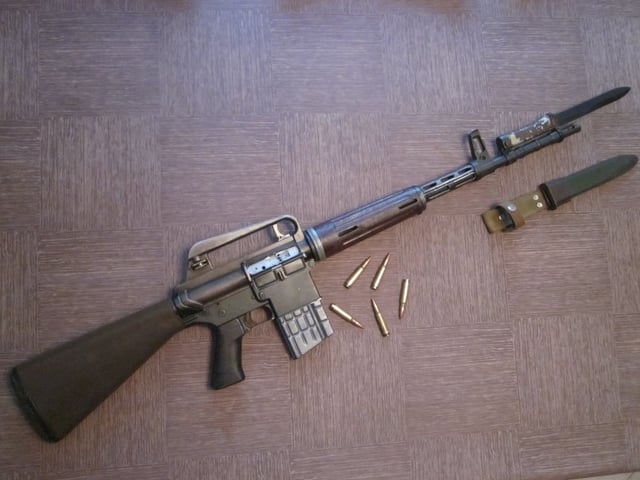
ArmaLite AR-10 with mounted bayonet made by Artillerie Inrichtingen (A.I.).
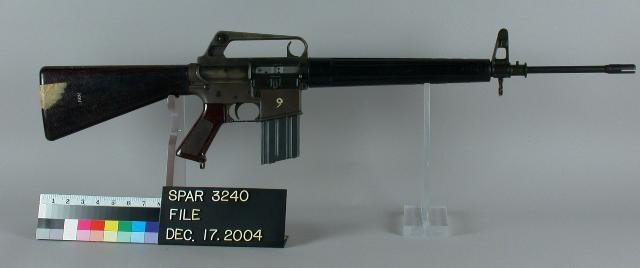
ArmaLite AR-15

An M16A1
In 1928, a U.S. Army 'Caliber Board' conducted firing tests at Aberdeen Proving Grounds and recommended transitioning to smaller caliber rounds, mentioning in particular the .27. Largely in deference to tradition, this recommendation was ignored and the Army referred to the .30 caliber as "full sized" for the next 35 years.[26] After World War II, the United States military started looking for a single automatic rifle to replace the M1 Garand, M1/M2 Carbines, M1918 Browning Automatic Rifle, M3 "Grease Gun" and Thompson submachine gun.[27][28] However, early experiments with select-fire versions of the M1 Garand proved disappointing.[29] During the Korean War, the select-fire M2 carbine largely replaced the submachine gun in US service[28] and became the most widely used carbine variant.[30] However, combat experience suggested that the .30 Carbine round was under-powered.[31] American weapons designers concluded that an intermediate round was necessary, and recommended a small-caliber, high-velocity cartridge.[32]
However, senior American commanders having faced fanatical enemies and experienced major logistical problems during WWII and the Korean War,[33][34][35][36][37] insisted that a single powerful .30 caliber cartridge be developed, that could not only be used by the new automatic rifle, but by the new general-purpose machine gun (GPMG) in concurrent development.[38][39] This culminated in the development of the 7.62×51mm NATO cartridge.[38]
The U.S. Army then began testing several rifles to replace the obsolete M1 Garand. Springfield Armory's T44E4 and heavier T44E5 were essentially updated versions of the Garand chambered for the new 7.62 mm round, while Fabrique Nationale submitted their FN FAL as the T48. ArmaLite entered the competition late, hurriedly submitting several AR-10 prototype rifles in the fall of 1956 to the U.S. Army's Springfield Armory for testing.[40] The AR-10 featured an innovative straight-line barrel/stock design, forged aluminum alloy receivers and with phenolic composite stocks.[41] It had rugged elevated sights, an oversized aluminum[42] flash suppressor and recoil compensator, and an adjustable gas system.[43] The final prototype featured an upper and lower receiver with the now-familiar hinge and takedown pins, and the charging handle was on top of the receiver placed inside of the carry handle.[40] For a 7.62mm NATO rifle, the AR-10 was incredibly lightweight at only 6.85 lb empty.[40] Initial comments by Springfield Armory test staff were favorable, and some testers commented that the AR-10 was the best lightweight automatic rifle ever tested by the Armory.[44][45] In the end the U.S. Army chose the T44 now named M14 rifle[38] which was an improved M1 Garand with a 20-round magazine and automatic fire capability.[46][47][48] The U.S. also adopted the M60 general purpose machine gun (GPMG).[38] Its NATO partners adopted the FN FAL and HK G3 rifles, as well as the FN MAG and Rheinmetall MG3 GPMGs.
The first confrontations between the AK-47 and the M14 came in the early part of the Vietnam War. Battlefield reports indicated that the M14 was uncontrollable in full-auto and that soldiers could not carry enough ammunition to maintain fire superiority over the AK-47.[46][49] And, while the M2 carbine offered a high rate of fire, it was under-powered and ultimately outclassed by the AK-47.[50] A replacement was needed: a medium between the traditional preference for high-powered rifles such as the M14, and the lightweight firepower of the M2 Carbine.
As a result, the Army was forced to reconsider a 1957 request by General Willard G. Wyman, commander of the U.S. Continental Army Command (CONARC) to develop a .223 inch caliber (5.56 mm) select-fire rifle weighing 6 lb (2.7 kg) when loaded with a 20-round magazine.[27] The 5.56 mm round had to penetrate a standard U.S. helmet at 500 yards (460 meters) and retain a velocity in excess of the speed of sound, while matching or exceeding the wounding ability of the .30 Carbine cartridge.[51]
This request ultimately resulted in the development of a scaled-down version of the Armalite AR-10, named ArmaLite AR-15 rifle.[52][53][54] In the late 1950s, designer Eugene Stoner was completing his work on the AR-15. The AR-15 used .22-caliber bullets, which destabilized when they hit a human body, as opposed to the .30 round, which typically passed through in a straight line. The smaller caliber meant that it could be controlled in autofire due the reduced recoil. Being almost one-third the weight of the .30 meant that the soldier could sustain fire for longer with the same load. Due to design innovations, the AR-15 could fire 600 to 700 rounds a minute with an extremely low jamming rate. Parts were stamped out, not hand-machined, so could be mass-produced, and the stock was plastic to reduce weight.[26]
In 1958, the Army's Combat Developments Experimentation Command ran experiments with small squads in combat situations using the M14, AR-15, and another rifle designed by Winchester. The resulting study recommended adopting a lightweight rifle like the AR-15. In response, the Army declared that all rifles and machine guns should use the same ammunition, and ordered full production of the M-14.[26] However, advocates for the AR-15 gained the attention of Air Force Chief of Staff General Curtis Lemay. After testing the AR-15 with the ammunition manufactured by Remington that Armalite and Colt recommended, the Air Force declared that the AR-15 was its 'standard model' and ordered 8,500 rifles and 8.5 million rounds.[26] Advocates for the AR-15 in the Defense Advanced Research Projects Agency acquired 1,000 Air Force AR-15s and shipped them to be tested by the Army of the Republic of Vietnam (ARVN). The South Vietnam soldiers issued glowing reports of the weapon's reliability, recording zero broken parts while firing 80,000 rounds in one stage of testing, and requiring only two replacement parts for the 1,000 weapons over the entire course of testing. The report of the experiment recommended that the U.S. provide the AR-15 as the standard rifle of the ARVN, but Admiral Harry Felt, then Commander in Chief, Pacific Forces, rejected the recommendations on the advice of the U.S. Army.[26]
Throughout 1962 and 1963, the U.S. military extensively tested the AR-15. Positive evaluations emphasized its lightness, "lethality", and reliability.[26] However, the Army Materiel Command criticized its inaccuracy at longer ranges and lack of penetrating power at higher ranges.[52][46][26] In early 1963, the U.S. Special Forces asked, and was given permission, to make the AR-15 its standard weapon. Other users included Army Airborne units in Vietnam and some units affiliated with the Central Intelligence Agency. As more units adopted the AR-15, Secretary of the Army Cyrus Vance ordered an investigation into why the weapon had been rejected by the Army. The resulting report found that Army Materiel Command had rigged the previous tests, selecting tests that would favor the M14 and choosing match grade M14s to compete against AR-15s out of the box.[26] At this point, the bureaucratic battle lines were well-defined, with the Army ordnance agencies opposed to the AR-15 and the Air Force and civilian leadership of the Defense Department in favor.[26]
In January 1963, Secretary of Defense Robert McNamara concluded that the AR-15 was the superior weapon system and ordered a halt to M14 production.[52][46] In late 1963, the Defense Department began mass procurement of rifles for the Air Force and special Army units. Secretary McNamara designated the Army as the procurer for the weapon with the Department, which allowed the Army ordnance establishment to modify the weapon as they wished. The first modification was the additions of a "manual bolt closure," allowing a soldier to ram in a round if it failed to seat properly. The Air Force, which was buying the rifle, and the Marine Corps, which had tested it both objected to this addition, with the Air Force noting, "During three years of testing and operation of the AR-15 rifle under all types of conditions the Air Force has no record of malfunctions that could have been corrected by a manual bolt closing device." They also noted that the closure added weight and complexity, reducing the reliability of the weapon. Colonel Howard Yount, who managed the Army procurement, would later state the bolt closure was added after direction from senior leadership, rather than as a result of any complaint or test result, and testified about the reasons: "the M-1, the M-14, and the carbine had always had something for the soldier to push on; that maybe this would be a comforting feeling to him, or something."[26][55]
After modifications,[53] the new redesigned rifle was subsequently adopted as the M16 Rifle.[1][52][46] "(The M16) was much lighter compared to the M14 it replaced, ultimately allowing soldiers to carry more ammunition. The air-cooled, gas-operated, magazine-fed assault rifle was made of steel, aluminum alloy and composite plastics, truly cutting-edge for the time. Designed with full and semi-automatic capabilities, the weapon initially did not respond well to wet and dirty conditions, sometimes even jamming in combat. After a few minor modifications, the weapon gained in popularity among troops on the battlefield."[46][56][57]
Despite its early failures the M16 proved to be a revolutionary design and stands as the longest continuously serving rifle in US military history.[1][52] It has been adopted by many US allies and the 5.56×45mm NATO cartridge has become not only the NATO standard, but "the standard assault-rifle cartridge in much of the world."[52][58][59] It also led to the development of small-caliber high-velocity service rifles by every major army in the world.[52] It is a benchmark against which other assault rifles are judged.[52][60][61]
M16s were produced by Colt until the late 1980s, when FN Herstal began to manufacture them.[62]
Adoption
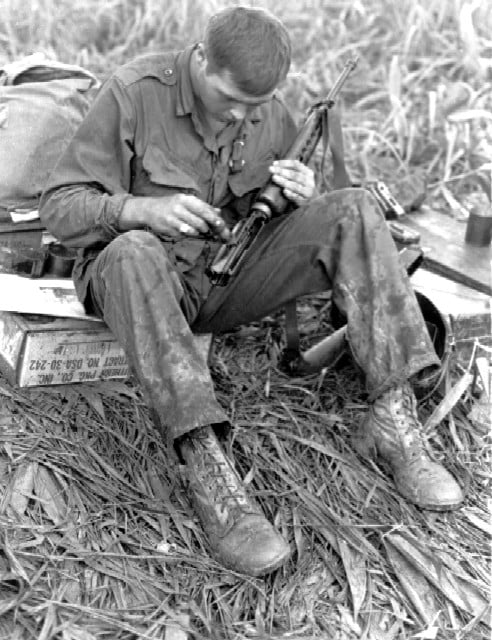
101st Airborne trooper cleans his XM16E1 during the Vietnam War in 1966
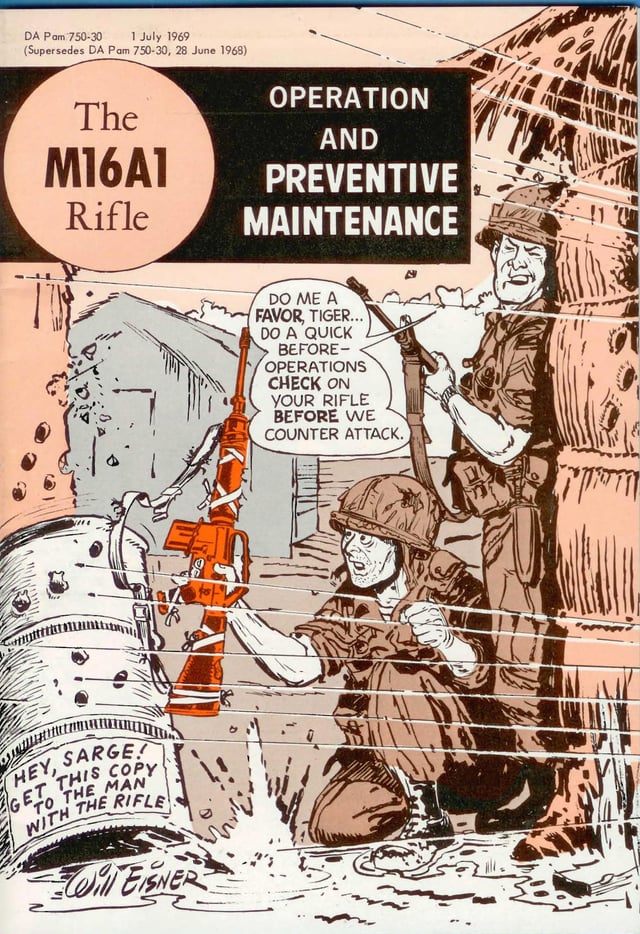
Front cover – The M16A1 Rifle – Operation and Preventive Maintenance by Will Eisner
In July 1960, General Curtis LeMay was impressed by a demonstration of the ArmaLite AR-15. In the summer of 1961, General LeMay was promoted to U.S. Air Force, Chief of Staff, and requested 80,000 AR-15s. However, General Maxwell D. Taylor, Chairman of the Joint Chiefs of Staff, advised President John F. Kennedy that having two different calibers within the military system at the same time would be problematic and the request was rejected.[63] In October 1961, William Godel, a senior man at the Advanced Research Projects Agency, sent 10 AR-15s to South Vietnam. The reception was enthusiastic, and in 1962 another 1,000 AR-15s were sent.[64] United States Army Special Forces personnel filed battlefield reports lavishly praising the AR-15 and the stopping-power of the 5.56 mm cartridge, and pressed for its adoption.[46]
The damage caused by the 5.56 mm bullet was originally believed to be caused by "tumbling" due to the slow 1 turn in 14-inch (360 mm) rifling twist rate.[46][63] However, any pointed lead core bullet will "tumble" after penetration in flesh, because the center of gravity is towards the rear of the bullet. The large wounds observed by soldiers in Vietnam were actually caused by bullet fragmentation created by a combination of the bullet's velocity and construction.[65] These wounds were so devastating, that the photographs remained classified into the 1980s.[66]
However, despite overwhelming evidence that the AR-15 could bring more firepower to bear than the M14, the Army opposed the adoption of the new rifle.[52][46] U.S. Secretary of Defense Robert McNamara now had two conflicting views: the ARPA report[67] favoring the AR-15 and the Army's position favoring the M14.[46] Even President Kennedy expressed concern, so McNamara ordered Secretary of the Army Cyrus Vance to test the M14, the AR-15 and the AK-47. The Army reported that only the M14 was suitable for service, but Vance wondered about the impartiality of those conducting the tests. He ordered the Army Inspector General to investigate the testing methods used; the Inspector General confirmed that the testers were biased towards the M14.
In January 1963, Secretary McNamara received reports that M14 production was insufficient to meet the needs of the armed forces and ordered a halt to M14 production.[46] At the time, the AR-15 was the only rifle that could fulfill a requirement of a "universal" infantry weapon for issue to all services. McNamara ordered its adoption, despite receiving reports of several deficiencies, most notably the lack of a chrome-plated chamber.[68][1]
After modifications (most notably, the charging handle was re-located from under the carrying handle like AR-10 to the rear of the receiver),[53] the new redesigned rifle was renamed the Rifle, Caliber 5.56 mm, M16.[1][52] Inexplicably, the modification to the new M16 did not include a chrome-plated barrel. Meanwhile, the Army relented and recommended the adoption of the M16 for jungle warfare operations. However, the Army insisted on the inclusion of a forward assist to help push the bolt into battery in the event that a cartridge failed to seat into the chamber. The Air Force, Colt and Eugene Stoner believed that the addition of a forward assist was an unjustified expense. As a result, the design was split into two variants: the Air Force's M16 without the forward assist, and the XM16E1 with the forward assist for the other service branches.
In November 1963, McNamara approved the U.S. Army's order of 85,000 XM16E1s;[46][69] and to appease General LeMay, the Air Force was granted an order for another 19,000 M16s.[70][71] In March 1964, the M16 rifle went into production and the Army accepted delivery of the first batch of 2,129 rifles later that year, and an additional 57,240 rifles the following year.[1]
In 1964, the Army was informed that DuPont could not mass-produce the IMR 4475 stick powder to the specifications demanded by the M16. Therefore, Olin Mathieson Company provided a high-performance ball propellant. While the Olin WC 846 powder achieved the desired 3,300 ft (1,000 m) per second muzzle velocity, it produced much more fouling, that quickly jammed the M16s action (unless the rifle was cleaned well and often).
In March 1965, the Army began to issue the XM16E1 to infantry units. However, the rifle was initially delivered without adequate cleaning kits[46] or instructions because Colt had claimed the M16 was self-cleaning. As a result, reports of stoppages in combat began to surface.[46] The most severe problem was known as "failure to extract"—the spent cartridge case remained lodged in the chamber after the rifle was fired.[46][72] Documented accounts of dead U.S. troops found next to disassembled rifles eventually led to a Congressional investigation.[46][73]
In February 1967, the improved XM16E1 was standardized as the M16A1.[70] The new rifle had a chrome-plated chamber and bore to eliminate corrosion and stuck cartridges and other, minor, modifications.[46] New cleaning kits, powder solvents and lubricants were also issued. Intensive training programs in weapons cleaning were instituted including a comic book-style operations manual.[75][76] As a result, reliability problems greatly diminished and the M16A1 rifle achieved widespread acceptance by U.S. troops in Vietnam.[46][57]
Reliability
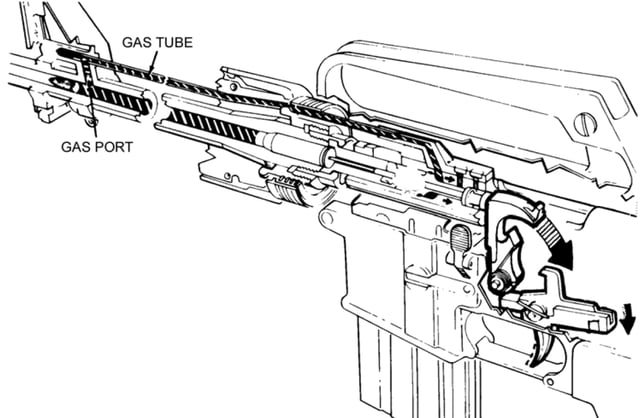
M16 direct impingement gas system
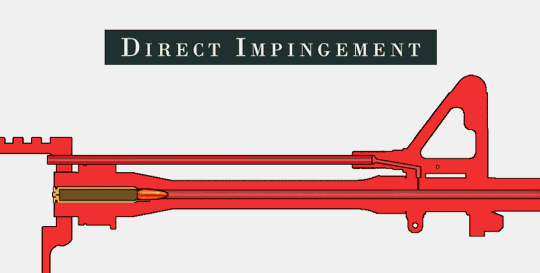
M16 direct impingement gas system
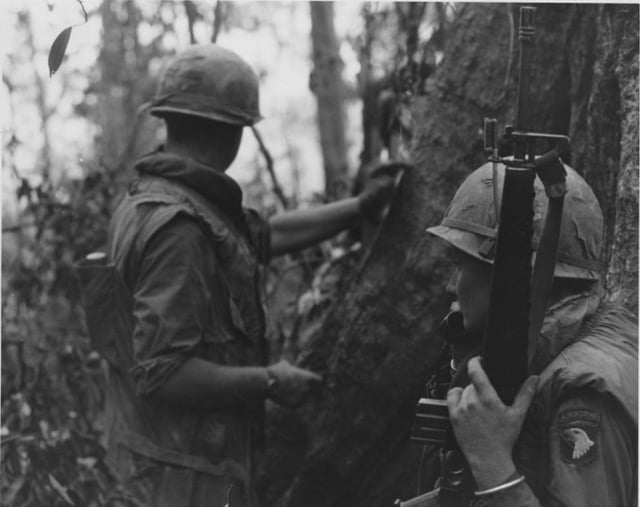
101st Airborne trooper carrying an M16A1 with a 20-round magazine during the Vietnam War, circa 1969
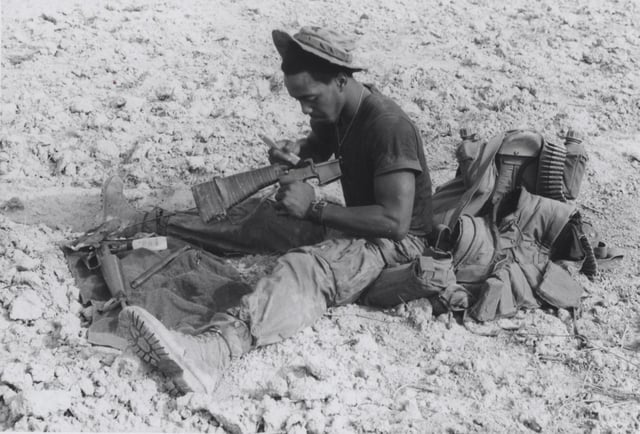
Sitting in the middle of a virtual dustbowl on Go Noi Island, a Marine pauses to clean his M16 rifle, Operation Pipestone Canyon, Vietnam, 1969
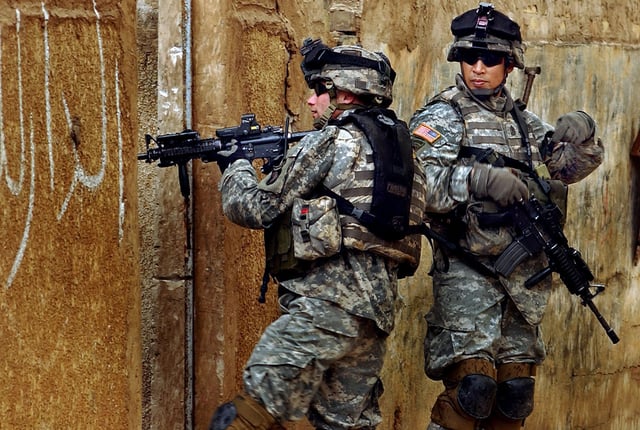
101st Airborne troopers on patrol with M4s in Sadr City, Iraq, c. 2006
During the early part of its career, the M16 had a reputation for poor reliability and a malfunction rate of two per 1000 rounds fired.[78] The M16's action works by passing high pressure propellant gasses tapped from the barrel down a tube and into the carrier group within the upper receiver, and is commonly referred to as a "direct impingement gas system". The gas goes from the gas tube, through the bolt carrier key, and into the inside of the carrier where it expands in a donut shaped gas cylinder. Because the bolt is prevented from moving forward by the barrel, the carrier is driven to the rear by the expanding gases and thus converts the energy of the gas to movement of the rifle's parts. The back part of the bolt forms a piston head and the cavity in the bolt carrier is the piston sleeve. It is more correct to call it an "internal piston" system."[79] This design is much lighter and more compact than a gas-piston design. However, this design requires that combustion byproducts from the discharged cartridge be blown into the receiver as well. This accumulating carbon and vaporized metal build-up within the receiver and bolt-carrier negatively affects reliability and necessitates more intensive maintenance on the part of the individual soldier. The channeling of gasses into the bolt carrier during operation increases the amount of heat that is deposited in the receiver while firing the M16 and causes essential lubricant to be "burned off". This requires frequent and generous applications of appropriate lubricant.[27] Lack of proper lubrication is the most common source of weapon stoppages or jams.[27]
The M16 was billed as self-cleaning (when no weapon is or ever has been).[1] The M16 was issued to troops without cleaning kits or instruction on how to clean the rifle.[1] The M16 and 5.56×45mm cartridge was tested and approved with the use of a DuPont IMR8208M extruded powder, that was switched to Olin Mathieson WC846 ball powder which produced much more fouling, that quickly jammed the action of the M16 (unless the gun was cleaned well and often).[1] The M16 lacked a forward assist (rendering the rifle inoperable when it jammed).[1] The M16 lacked a chrome-plated chamber, which allowed corrosion problems and contributed to case extraction failures (which was considered the most severe problem and required extreme measures to clear, such as inserting the cleaning-rod down the barrel and knocking the spent cartridge out).[1]
When these issues were addressed and corrected by the M16A1, the reliability problems decreased greatly.[70] According to a 1968 Department of Army report, the M16A1 rifle achieved widespread acceptance by U.S. troops in Vietnam.[57] "Most men armed with the M16 in Vietnam rated this rifle's performance high, however, many men entertained some misgivings about the M16's reliability. When asked what weapon they preferred to carry in combat, 85 percent indicated that they wanted either the M16 or its [smaller] submachine gun version, the XM177E2." Also "the M14 was preferred by 15 percent, while less than one percent wished to carry either the Stoner rifle, the AK-47, the carbine or a pistol."[57] In March 1970, the "President's Blue Ribbon Defense Panel" concluded that the issuance of the M16 saved the lives of 20,000 U.S. servicemen during the Vietnam War, who would have otherwise died had the M14 remained in service.[81] However, the M16 rifle's reputation continues to suffer.[70][82]
After the introduction of the M4 Carbine, it was found that the shorter barrel length of 14.5 inches also has a negative effect on reliability, as the gas port is located closer to the chamber than the gas port of the standard length M16 rifle: 7.5 inches instead of 13 inches.[83] This affects the M4's timing and increases the amount of stress and heat on the critical components, thereby reducing reliability.[83] In a 2002 assessment the USMC found that the M4 malfunctioned three times more often than the M16A4 (the M4 failed 186 times for 69,000 rounds fired, while the M16A4 failed 61 times).[84] Thereafter, the Army and Colt worked to make modifications to the M4s and M16A4s in order to address the problems found.[84] In tests conducted in 2005 and 2006 the Army found that on average, the new M4s and M16s fired approximately 5,000 rounds between stoppages.[84][85]
In December 2006, the Center for Naval Analyses (CNA) released a report on U.S. small arms in combat. The CNA conducted surveys on 2,608 troops returning from combat in Iraq and Afghanistan over the past 12 months. Only troops who had fired their weapons at enemy targets were allowed to participate. 1,188 troops were armed with M16A2 or A4 rifles, making up 46 percent of the survey. 75 percent of M16 users (891 troops) reported they were satisfied with the weapon. 60 percent (713 troops) were satisfied with handling qualities such as handguards, size, and weight. Of the 40 percent dissatisfied, most were with its size. Only 19 percent of M16 users (226 troops) reported a stoppage, while 80 percent of those that experienced a stoppage said it had little impact on their ability to clear the stoppage and re-engage their target. Half of the M16 users never experienced failures of their magazines to feed. 83 percent (986 troops) did not need their rifles repaired while in theater. 71 percent (843 troops) were confident in the M16's reliability, defined as level of soldier confidence their weapon will fire without malfunction, and 72 percent (855 troops) were confident in its durability, defined as level of soldier confidence their weapon will not break or need repair. Both factors were attributed to high levels of soldiers performing their own maintenance. 60 percent of M16 users offered recommendations for improvements. Requests included greater bullet lethality, new-built instead of rebuilt rifles, better quality magazines, decreased weight, and a collapsible stock. Some users recommended shorter and lighter weapons such as M4 carbine.[86] Some issues have been addressed with the issuing of the Improved STANAG magazine in March 2009,[87][88] and the M855A1 Enhanced Performance Round in June 2010.[89]
In early 2010, two journalists from The New York Times spent three months with soldiers and Marines in Afghanistan. While there, they questioned around 100 infantry troops about the reliability of their M16 rifles, as well as the M4 carbine. The troops did not report reliability problems with their rifles. While only 100 troops were asked, they engaged in daily fighting in Marja, including least a dozen intense engagements in Helmand Province, where the ground is covered in fine powdered sand (called "moon dust" by troops) that can stick to firearms.[90] Weapons were often dusty, wet, and covered in mud. Intense firefights lasted hours with several magazines being expended. Only one soldier reported a jam when his M16 was covered in mud after climbing out of a canal. The weapon was cleared and resumed firing with the next chambered round. Furthermore, the Marine Chief Warrant Officer responsible for weapons training and performance of the Third Battalion, Sixth Marines, reported that "We've had nil in the way of problems; we've had no issues." with his battalion's 350 M16s and 700 M4s.[90]
Design

Video...Rifle 5.56mm, XM16E1. Operation and Cycle of Functioning.

M16A1 rifle
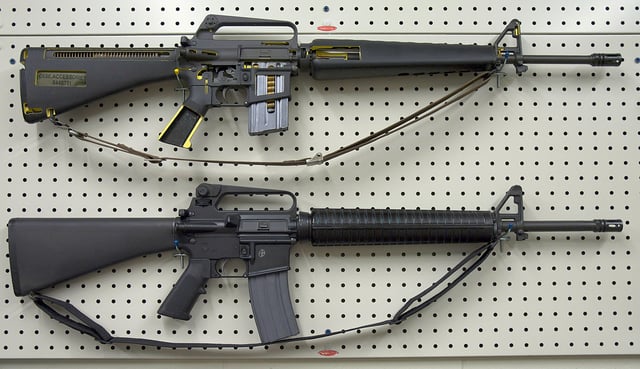
M16A1 cutaway rifle (top) M16A2 (below)
The M16 is a lightweight, 5.56 mm, air-cooled, gas-operated, magazine-fed assault rifle, with a rotating bolt. The M16's receivers are made of 7075 aluminum alloy, its barrel, bolt, and bolt carrier of steel, and its handguards, pistol grip, and buttstock of plastics.
The M16A1 was especially lightweight at 7.9 pounds (3.6 kg) with a loaded 30-round magazine.[91] This was significantly less than the M14 that it replaced at 10.7 pounds (4.9 kg) with a loaded 20-round magazine.[92] It is also lighter when compared to the AKM's 8.3 pounds (3.8 kg) with a loaded 30-round magazine.[93]
The M16A2 weighs 8.8 lb (4.0 kg) loaded with a 30-round magazine,[94] because of the adoption of a thicker barrel profile. The thicker barrel is more resistant to damage when handled roughly and is also slower to overheat during sustained fire. Unlike a traditional "bull" barrel that is thick its entire length, the M16A2's barrel is only thick forward of the handguards. The barrel profile under the handguards remained the same as the M16A1 for compatibility with the M203 grenade launcher.
Barrel
Early model M16 barrels had a rifling twist of 4 grooves, right hand twist, 1 turn in 14 inches (1:355.6 mm) bore – as it was the same rifling used by the .222 Remington sporting round. This was shown to make the light .223 Remington bullet yaw in flight at long ranges and it was soon replaced. Later models had an improved rifling with 6 grooves, right hand twist, 1 turn in 12 inches (1:304.8 mm) for increased accuracy and was optimized for use with the standard U.S. M193 cartridge. Current models are optimized for the heavier NATO SS109 bullet and have 6 grooves, right hand twist, 1 turn in 7 in (1:177.8 mm).[95][96][97][98] Weapons designed to accept both the M193 or SS109 rounds (like civilian market clones) usually have a 6-groove, right hand twist, 1 turn in 9 inches (1:228.6 mm) bore, although 1:8 inches and 1:7 inches twist rates are available as well.
Recoil
"The (M16's) Stoner system provides a very symmetric design that allows straight line movement of the operating components. This allows recoil forces to drive straight to the rear. Instead of connecting or other mechanical parts driving the system, high pressure gas performs this function, reducing the weight of moving parts and the rifle as a whole."[79] The M16's straight-line recoil design, where the recoil spring is located in the stock directly behind the action,[99] and serves the dual function of operating spring and recoil buffer.[99] The stock being in line with the bore also reduces muzzle rise, especially during automatic fire. Because recoil does not significantly shift the point of aim, faster follow-up shots are possible and user fatigue is reduced. Also, current model M16 flash-suppressors also act as compensators to reduce recoil further.[100]
| Free recoil[101] | |
|---|---|
| M16 | |
| Momentum | 40.4 lb-ft/s |
| Velocity | 5.1 ft/s (1.6 m/s) |
| Energy | 3.2 ft⋅lb (4.3 J) |
Notes: Free recoil is mathematical equation calculated by using the rifle weight, bullet weight, muzzle velocity, and charge weight.[101] It is that which would be measured if the rifle were fired suspended from strings, free to recoil.[101] A rifle's perceived recoil is also dependent on many other factors which are not readily quantified.[101]
Sights
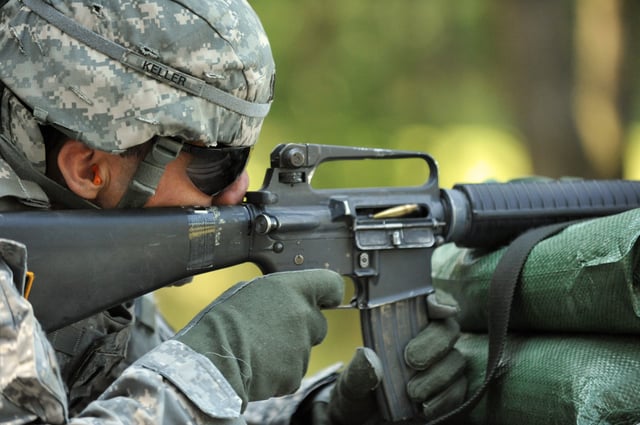
U.S. soldier fires M16A2. Note: upper receiver showing carrying handle and rear sight
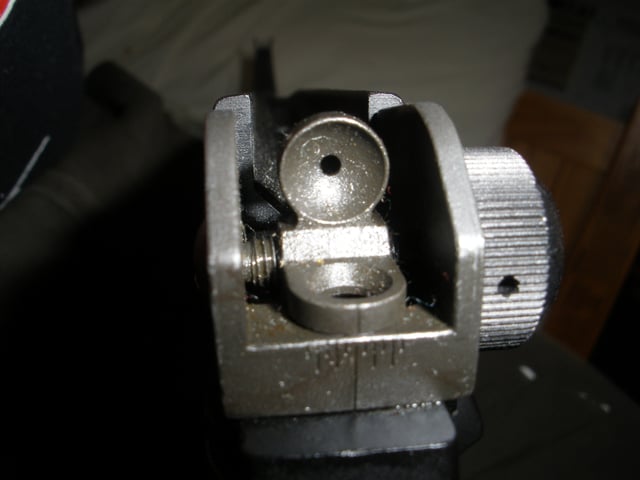
M16A2 rear sight
The M16's most distinctive ergonomic feature is the carrying handle and rear sight assembly on top of the receiver. This is a by-product of the original design, where the carry handle served to protect the charging handle.[99] As the line of sight is 2.5 in (63.5 mm) over the bore, the M16 has an inherent parallax problem. At closer ranges (typically inside 15–20 meters), the shooter must compensate by aiming high to place shots where desired. The M16 has a 500 mm (19.75 inches) sight radius.[102] The M16 uses an L-type flip, aperture rear sight and it is adjustable with two settings: 0 to 300 meters and 300 to 400 meters.[103] The front sight is a post adjustable for elevation in the field. The rear sight can be adjusted in the field for windage. The sights can be adjusted with a bullet tip or pointed tool, as troops are trained to zero their own rifles. The sight picture is the same as the M14, M1 Garand, M1 Carbine and the M1917 Enfield. The M16 also has a "Low Light Level Sight System", which includes a front sight post with a weak light source provided by tritium radioluminescence in an embedded small glass vial and a larger aperture rear sight.[104]
The M16 can also mount a scope on the carrying handle. With the advent of the M16A2, a new fully adjustable rear sight was added, allowing the rear sight to be dialed in for specific range settings between 300 and 800 meters and to allow windage adjustments without the need of a tool or cartridge.[105] Modern versions such as M16A4 have a detachable carrying handle and use Picatinny rails, which allows for the use of various scopes and sighting devices. The current U.S. Army and Air Force issue M4 Carbine comes with the M68 Close Combat Optic and Back-up Iron Sight.[106][107] The U.S. Marine Corps uses the ACOG Rifle Combat Optic[108][109] and the U.S. Navy uses EOTech Holographic Weapon Sight.[110]
Range and accuracy

NATO E-type Silhouette Target
The M16 rifle is considered to be very accurate.[111][112][113][114] Its light recoil, high-velocity and flat trajectory allow shooters to take head shots out to 300 meters.[115][116] Newer M16s use the newer M855 cartridge increasing their effective range to 600 meters.[117] They are more accurate than their predecessors and are capable of shooting 1–3 inch groups at 100 yards.[118][119] "In Fallujah, [Iraq] Marines with ACOG-equipped M16A4s created a stir by taking so many head shots that until the wounds were closely examined, some observers thought the insurgents had been executed."[120] The newest M855A1 EPR cartridge is even more accurate and during testing "...has shown that, on average, 95 percent of the rounds will hit within an 8 × 8-inch target at 600 meters."[121]
| Rifle | Caliber | Cartridge | Cartridge weight | Bullet weight | Velocity | Energy | Range | Accuracy | ||||
|---|---|---|---|---|---|---|---|---|---|---|---|---|
| Effective* | Horizontal** | Lethal*** | Maximum**** | 10 shot group @ 100 meters | 10 shot group @ 300 meters | |||||||
| M16 | 5.56×45mm | M193 | 184 gr (11.9 g)[122] | 55 gr (3.6 g)[123] | 3,250 fps (990 m/s)[123] | 1,302 ft/lb (1,764 J)[123] | 500 yds (460 m)[103] | 711 yds (650 m)[122] | 984 yds (900 m)[122] | 3000 yds (2700 m)[122] | 4.3 in (11 cm)[122] | 12.6 in (32 cm)[124] |
Note *: The effective range of a firearm is the maximum distance at which a weapon may be expected to be accurate and achieve the desired effect.[125] Note **: The horizontal range is the distance traveled by a bullet, fired from the rifle at a height of 1.6 meters and 0° elevation, until the bullet hits the ground.[126] Note ***: The lethal range is the maximum range of a small-arms projectile, while still maintaining the minimum energy required to put a man out of action, which is generally believed to be 15 kilogram-meters (108 ft.-Ibs.).[122] This is the equivalent of the muzzle energy of a .22LR handgun.[127] Note ****: The maximum range of a small-arms projectile is attained at about 30° elevation. This maximum range is only of safety interest, not for combat firing.[122]
| Single-shot hit-probability on Crouching Man (NATO E-type Silhouette) Target[128] | ||||||||||
|---|---|---|---|---|---|---|---|---|---|---|
| Rifle | Chambering | Hit-probability (With no range estimation or aiming errors) | ||||||||
| 50 meters | 100 meters | 200 meters | 300 meters | 400 meters | 500 meters | 600 meters | 700 meters | 800 meters | ||
| M16A1 (1967) | 5.56×45mm NATO M193 | 100% | 100% | 100% | 100% | 96% | 87% | 73% | 56% | 39% |
| M16A2 (1982) | 5.56×45mm NATO SS109/M855 | 100% | 100% | 100% | 100% | 98% | 90% | 79% | 63% | 43% |
Terminal ballistics
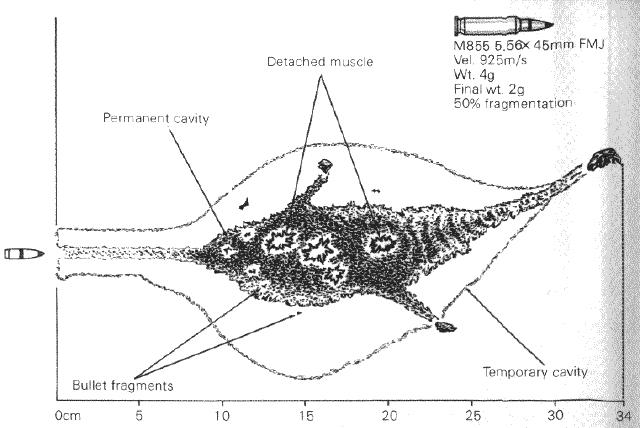
M16A2 SS109/M855 5.56×45mm NATO
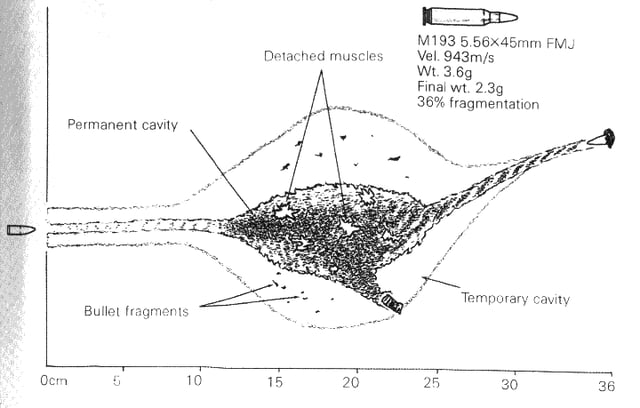
M16 M193 5.56×45mm
The 5.56×45mm cartridge had several advantages over the 7.62×51mm NATO round used in the M14 rifle. It enabled each soldier to carry more ammunition and was easier to control during automatic or burst fire.[129] The 5.56×45mm NATO cartridge can also produce massive wounding effects when the bullet impacts at high speed and yaws ("tumbles") in tissue leading to fragmentation and rapid transfer of energy.[130][131][132]
| Rifle | Caliber | Cartridge | Penetration | ||||||
|---|---|---|---|---|---|---|---|---|---|
| Ballistic gelatin @ 10 meters | Sandbags @ 100 meters | 3/4" pine boards @ 100 meters | Concrete building block (one center rib) | Steel helmet | 1.9mm steel (14 gauge) @ 100 meters | 4mm steel (8 gauge)
Kevlar-29 | |||
| M16 | 5.56×45mm | M193 | ≈14 in (36 cm) (bullet fragments into smaller pieces)[133][134] | 4 in (10 cm) (complete bullet disintegration)[135] | 8 boards (bullet tumbled)[135] | one side to 200 m[135] | both sides to 300 m one side to 500 m[135] | 2 layers[135] | 31 layers of Kevlar[136] |
The original ammunition for the M16 was the 55-grain M193 cartridge. When fired from a 20" barrel at ranges of up to 100 meters, the thin-jacketed lead-cored round traveled fast enough (above 2900 ft/s) that the force of striking a human body would cause the round to yaw (or tumble) and fragment into about a dozen pieces of various sizes thus created wounds that were out of proportion to its caliber.[133][134] These wounds were so devastating that many considered the M16 to be an inhumane weapon.[137][138][139] As the 5.56mm round's velocity decreases, so does the number of fragments that it produces.[27] The 5.56mm round does not normally fragment at distances beyond 200 meters or at velocities below 2500 ft/s, and its lethality becomes largely dependent on shot placement.[27][134]
With the development of the M16A2, the new 62-grain M855 cartridge was adopted in 1983. The heavier bullet had more energy, and was made with a steel core to penetrate Soviet body armor. However, this caused less fragmentation on impact and reduced effects against targets without armor, both of which lessened kinetic energy transfer and wounding ability.[72] Some soldiers and Marines coped with this through training, with requirements to shoot vital areas three times to guarantee killing the target.[140]
However, there have been repeated and consistent reports of the M855's inability to wound effectively (i.e. fragment) when fired from the short barreled M4 carbine (even at close ranges).[27] The M4's 14.5" barrel length reduces muzzle velocity to about 2900 ft/s.[141] This reduced wounding ability is one reason that, despite the Army's transition to short-barrel M4's, the Marine Corps has decided to continue using the M16A4 with its 20″ barrel as the 5.56×45mm M855 is largely dependent upon high velocity in order to wound effectively.[27]
In 2003, the U.S. Army contended that the lack of lethality of the 5.56×45mm was more a matter of perception than fact.[142][143] With good shot placement to the head and chest, the target was usually defeated without issue.[142][144] The majority of failures were the result of hitting the target in non-vital areas such as extremities.[142] However, a minority of failures occurred in spite of multiple hits to the chest.[142] In 2006, a study found that 20% of soldiers using the M4 Carbine wanted more lethality or stopping power.[145] In June 2010, the U.S. Army announced it began shipping its new 5.56mm, lead-free, M855A1 Enhanced Performance Round to active combat zones.[146] This upgrade is designed to maximize performance of the 5.56×45mm round, to extend range, improve accuracy, increase penetration and to consistently fragment in soft-tissue when fired from not only standard length M16s, but also the short-barreled M4 carbines.[121][146][147] The U.S. Army has been so impressed with the new M855A1 EPR round[148][149] that they developed a 7.62 NATO M80A1 EPR variant.[150][151]
Magazines
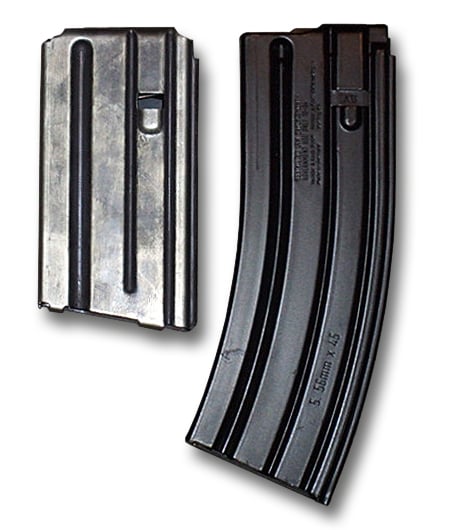
Vietnam War-era 20-round magazine (left) and Current issue NATO STANAG 30-round magazine (right)
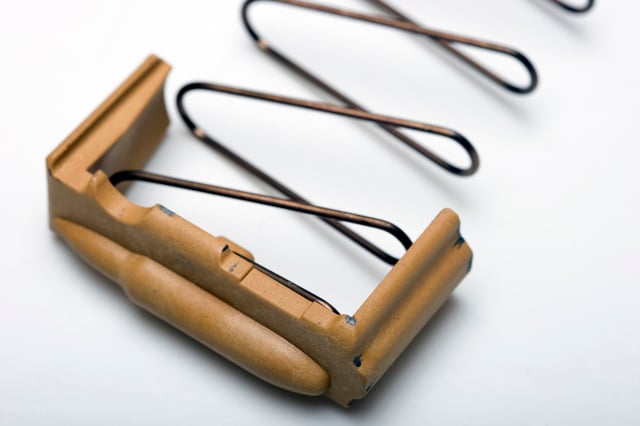
Improved tan colored M16 magazine follower
The M16's magazine was meant to be a lightweight, disposable item.[152][153] As such, it is made of pressed/stamped aluminum and was not designed to be durable.[152] The M16 originally used a 20-round magazine which was later replaced by a bent 30-round design. As a result, the magazine follower tends to rock or tilt, causing malfunctions.[153] Many non-U.S. and commercial magazines have been developed to effectively mitigate these shortcomings (e.g., H&K's all-stainless-steel magazine, Magpul's polymer P-MAG, etc.).[152][153]
Production of the 30-round magazine started late 1967 but did not fully replace the 20-round magazine until the mid-1970s.[153] Standard USGI aluminum 30-round M16 magazines weigh 0.24 lb (0.11 kg) empty and are 7.1 inches (18 cm) long.[154][155] The newer plastic magazines are about a half inch longer.[156] The newer steel magazines are about 0.5 inch longer and four ounces heavier.[157] The M16's magazine has become the unofficial NATO STANAG magazine and is currently used by many Western Nations, in numerous weapon systems.[158][159]
In 2009, the U.S. Military began fielding an "improved magazine" identified by a tan-colored follower.[160][161] "The new follower incorporates an extended rear leg and modified bullet protrusion for improved round stacking and orientation. The self-leveling/anti-tilt follower minimizes jamming while a wider spring coil profile creates even force distribution. The performance gains have not added weight or cost to the magazines."[161]
In July 2016, the U.S. Army introduced another improvement, the new Enhanced Performance Magazine, which it says will result in a 300% increase in reliability in the M4 Carbine. Developed by the United States Army Armament Research, Development and Engineering Center and the Army Research Laboratory in 2013, it is tan colored with blue follower to distinguish it from earlier, incompatible magazines.[162]
Muzzle devices
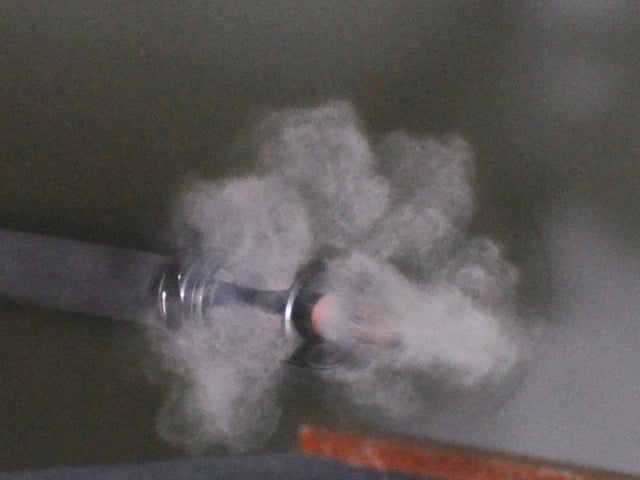
Bullet exiting an A2-style flash suppressor
Most M16 rifles have a barrel threaded in 1⁄2-28" threads to incorporate the use of a muzzle device such as a flash suppressor or sound suppressor.[163] The initial flash suppressor design had three tines or prongs and was designed to preserve the shooter's night vision by disrupting the flash. Unfortunately it was prone to breakage and getting entangled in vegetation. The design was later changed to close the end to avoid this and became known as the "A1" or "bird cage" flash suppressor on the M16A1. Eventually on the M16A2 version of the rifle, the bottom port was closed to reduce muzzle climb and prevent dust from rising when the rifle was fired in the prone position.[164] For these reasons, the U.S. military declared the A2 flash suppressor as a compensator or a muzzle brake; but it is more commonly known as the "GI" or "A2" flash suppressor.[129]
The M16's Vortex Flash Hider weighs 3 ounces, is 2.25 inches long, and does not require a lock washer to attach to barrel.[165] It was developed in 1984, and is one of the earliest privately designed muzzle devices. The U.S. military uses the Vortex Flash Hider on M4 carbines and M16 rifles.[166][167] A version of the Vortex has been adopted by the Canadian Military for the Colt Canada C8 CQB rifle.[168] Other flash suppressors developed for the M16 include the Phantom Flash Suppressor by Yankee Hill Machine (YHM) and the KX-3 by Noveske Rifleworks.[169]
The threaded barrel allows sound suppressors with the same thread pattern to be installed directly to the barrel; however this can result in complications such as being unable to remove the suppressor from the barrel due to repeated firing on full auto or three-round burst.[170] A number of suppressor manufacturers have designed "direct-connect" sound suppressors which can be installed over an existing M16's flash suppressor as opposed to using the barrel's threads.[170]
Grenade launchers and shotguns
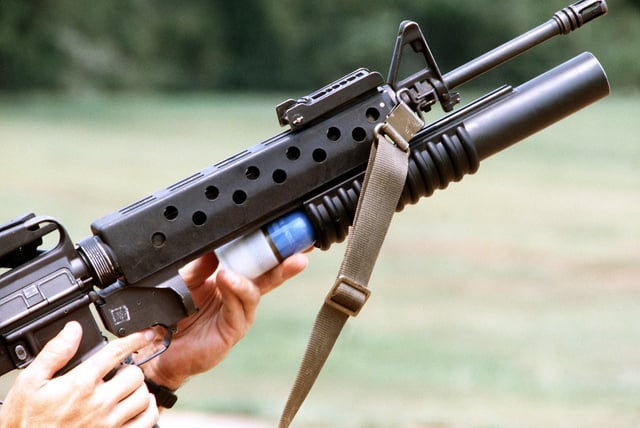
Loading an M203 40 mm grenade launcher attached to an M16 rifle with a practice round
All current M16 type rifles can mount under-barrel 40 mm grenade-launchers, such as the M203 and M320. Both use the same 40 mm grenades as the older, stand-alone M79 grenade launcher. The M16 can also mount under-barrel 12 gauge shotguns such as KAC Masterkey or the M26 Modular Accessory Shotgun System.
Riot Control Launcher

M234 Riot Control Launcher
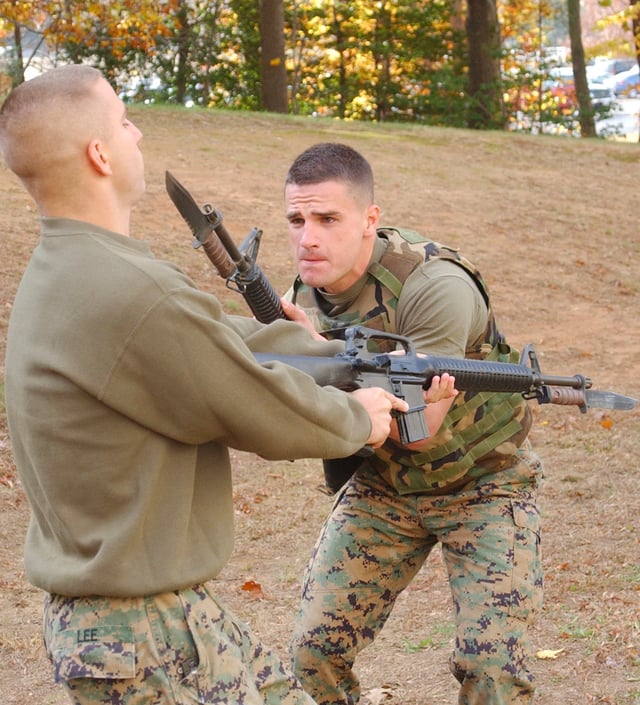
USMC M16A2s with the OKC-3S bayonet
The M234 Riot Control Launcher is an M16-series rifle attachment firing an M755 blank round. The M234 mounts on the muzzle, bayonet lug and front sight post of the M16. It fires either the M734 64 mm Kinetic Riot Control or the M742 64 mm CSI Riot Control Ring Airfoil Projectiles. The latter produces a 4 to 5 foot tear gas cloud on impact. The main advantage to using Ring Airfoil Projectiles is that their design does not allow them be thrown back by rioters with any real effect. The M234 is no longer used by U.S. forces. It has been replaced by the M203 40 mm grenade launcher and nonlethal ammunition.
Bayonet
The M16 is 44.25 inches (1124 mm) long with an M7 bayonet attached.[103] The M7 bayonet is based on earlier designs such as the M4, M5, & M6 bayonets, all of which are direct descendants of the M3 Fighting Knife and have spear-point blade with a half sharpened secondary edge. The newer M9 bayonet has a clip-point blade with saw teeth along the spine, and can be used as a multi-purpose knife and wire-cutter when combined with its scabbard. The current USMC OKC-3S bayonet bears a resemblance to the Marines' iconic Ka-Bar fighting knife with serrations near the handle.
Bipod
The M3 bipod continues to be referenced in at least one official manual as late as 1985, where it is stated one of the most stable firing positions is "the prone biped [sic] supported for automatic fire."[173]
NATO standards
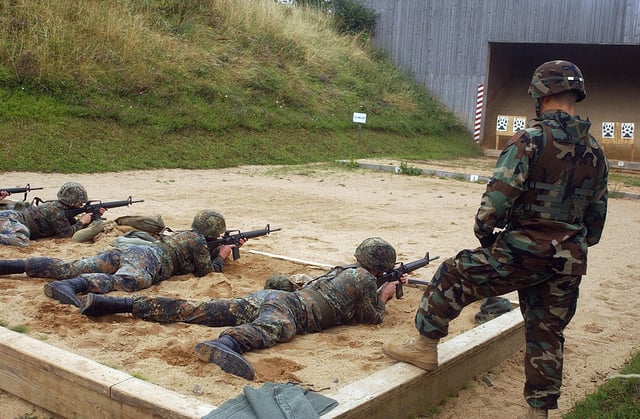
German Army soldiers of the 13th Panzergrenadier Division qualify with the M16A2 at Würzburg, as part of a partnership range with the U.S. 1st Infantry Division

Video of U.S. troops using GREM (Simon) rifle grenade system
In March 1970, the U.S. recommended that all NATO forces adopt the 5.56×45mm cartridge.[59] This shift represented a change in the philosophy of the military's long-held position about caliber size. By the mid 1970s, other armies were looking at M16-style weapons. A NATO standardization effort soon started and tests of various rounds were carried out starting in 1977.[59] The U.S. offered the 5.56×45mm M193 round, but there were concerns about its penetration in the face of the wider introduction of body armor.[27] In the end the Belgian 5.56×45mm SS109 round was chosen (STANAG 4172) in October 1980.[59] The SS109 round was based on the U.S. cartridge but included a new stronger, heavier, 62 grain bullet design, with better long range performance and improved penetration (specifically, to consistently penetrate the side of a steel helmet at 600 meters).[27] Due to its design and lower muzzle velocity (about 3110 ft/s)[174] the Belgian SS109 round is considered more humane because it is less likely to fragment than the U.S. M193 round.[137] The NATO 5.56×45mm standard ammunition produced for U.S. forces is designated M855.
In October 1980, shortly after NATO accepted the 5.56×45mm NATO rifle cartridge.[175] Draft Standardization Agreement 4179 (STANAG 4179) was proposed to allow NATO members to easily share rifle ammunition and magazines down to the individual soldier level. The magazine chosen to become the STANAG magazine was originally designed for the U.S. M16 rifle. Many NATO member nations, but not all, subsequently developed or purchased rifles with the ability to accept this type of magazine. However, the standard was never ratified and remains a 'Draft STANAG'.[176]
All current M16 type rifles are designed to fire STANAG 22 mm rifle grenades from their integral flash hiders without the use of an adapter. These 22 mm grenade types range from anti-tank rounds to simple finned tubes with a fragmentation hand grenade attached to the end. They come in the "standard" type which are propelled by a blank cartridge inserted into the chamber of the rifle. They also come in the "bullet trap" and "shoot through" types, as their names imply, they use live ammunition. The U.S. military does not generally use rifle grenades; however, they are used by other nations.[177]
The NATO Accessory Rail STANAG 4694, or Picatinny rail STANAG 2324, or a "Tactical Rail" is a bracket used on M16 type rifles to provide a standardized mounting platform. The rail comprises a series of ridges with a T-shaped cross-section interspersed with flat "spacing slots". Scopes are mounted either by sliding them on from one end or the other; by means of a "rail-grabber" which is clamped to the rail with bolts, thumbscrews or levers; or onto the slots between the raised sections. The rail was originally for scopes. However, once established, the use of the system was expanded to other accessories, such as tactical lights, laser aiming modules, night vision devices, reflex sights, foregrips, bipods, and bayonets.
Currently, the M16 is in use by 15 NATO countries and more than 80 countries worldwide.
ArmaLite AR-15
ArmaLite AR-15
The weapon that eventually became the M16 series was basically a scaled down AR-10 with an ambidextrous charging handle located within the carrying handle, a narrower front sight "A" frame, and no flash suppressor.[178]
Colt ArmaLite AR-15 (Models 601 & 602)
Colt's first two models produced after the acquisition of the rifle from ArmaLite were the 601 and 602, and these rifles were in many ways clones of the original ArmaLite rifle (in fact, these rifles were often found stamped Colt ArmaLite AR-15, Property of the U.S. Government caliber .223, with no reference to them being M16s).[179] The 601 and 602 are easily identified by their flat lower receivers without raised surfaces around the magazine well and occasionally green or brown furniture. The 601 was adopted first of any of the rifles by the USAF, and was quickly supplemented with the XM16 (Colt Model 602) and later the M16 (Colt Model 604) as improvements were made. There was also a limited purchase of 602s, and a number of both of these rifles found their way to a number of Special Operations units then operating in South East Asia, most notably the U.S. Navy SEALs. The only major difference between the 601 and 602 is the switch from the original 1:14-inch rifling twist to the more common 1:12-inch twist. These weapons were equipped with a triangular charging handle and a bolt hold open device that lacked a raised lower engagement surface. The bolt hold open device had a slanted and serrated surface that had to be engaged with a bare thumb, index finger, or thumb nail because of the lack of this surface. The U.S. Air Force continued to use the ArmaLite AR-15 marked rifles in various configurations into the 1990s.
Variants
M16
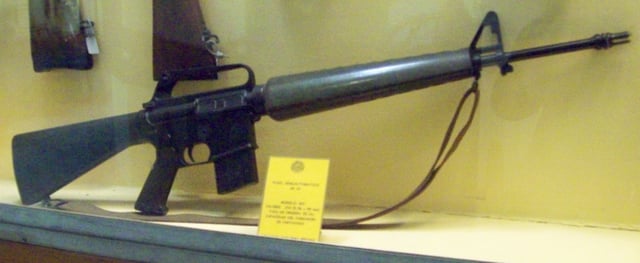
An early M16 rifle without forward-assist. Note: "duckbill" flash suppressor and triangular grip
This was the first M16 variant adopted operationally, originally by the U.S. Air Force. It was equipped with triangular handguards, butt stocks without a compartment for the storage of a cleaning kit,[180] a three-pronged flash suppressor, full auto, and no forward assist. Bolt carriers were originally chrome plated and slick-sided, lacking forward assist notches. Later, the chrome plated carriers were dropped in favor of Army issued notched and parkerized carriers though the interior portion of the bolt carrier is still chrome-lined. The Air Force continued to operate these weapons until around 2001, at which time the Air Force converted all of its M16s to the M16A2 configuration.
The M16 was also adopted by the British SAS, who used it during the Falklands War.[181]
XM16E1 and M16A1 (Colt Model 603)
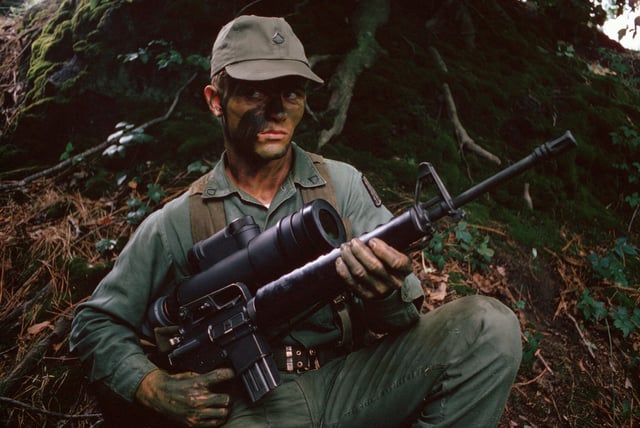
A Vietnam War-era infantryman armed with an M16A1 rifle and an AN/PVS-2 Starlight scope for use at night.
The U.S. Army XM16E1 was essentially the same weapon as the M16 with the addition of a forward assist and corresponding notches in the bolt carrier. The M16A1 was the finalized production model in 1967 and was produced until 1982.
To address issues raised by the XM16E1's testing cycle, a closed, bird-cage flash suppressor replaced the XM16E1's three-pronged flash suppressor which caught on twigs and leaves. Various other changes were made after numerous problems in the field. Cleaning kits were developed and issued while barrels with chrome-plated chambers and later fully lined bores were introduced.
With these and other changes, the malfunction rate slowly declined and new soldiers were generally unfamiliar with early problems. A rib was built into the side of the receiver on the XM16E1 to help prevent accidentally pressing the magazine release button while closing the ejection port cover. This rib was later extended on production M16A1s to help in preventing the magazine release from inadvertently being pressed. The hole in the bolt that accepts the cam pin was crimped inward on one side, in such a way that the cam pin may not be inserted with the bolt installed backwards, which would cause failures to eject until corrected. The M16A1 saw limited use in training capacities until the early 2000s,[182][183][184] but is no longer in active service with the U.S., although is still standard issue in many world armies.
M16A2
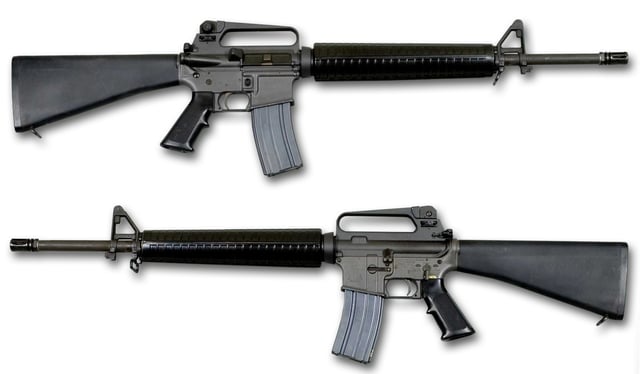
M16A2
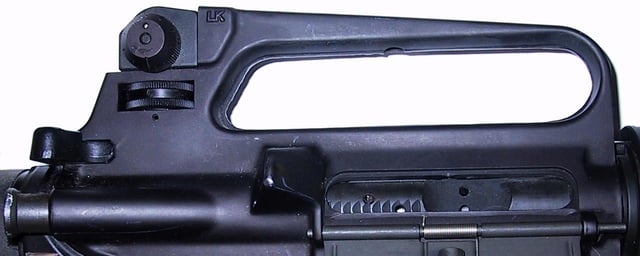
New rear sight, brass deflector and forward assist of M16A2
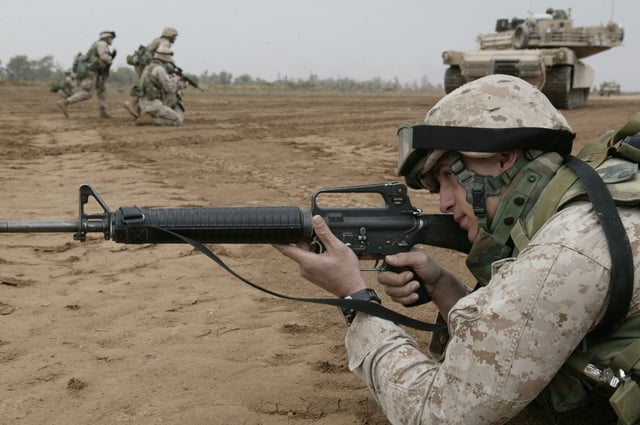
A U.S. Marine with an M16A2 on a training exercise at Camp Baharia, Iraq, 2004
The development of the M16A2 rifle was originally requested by the United States Marine Corps as a result of combat experience in Vietnam with the XM16E1 and M16A1. It was officially adopted by the Department of Defense as the "US Rifle, 5.56mm, M16A2" in 1982. The Marines were the first branch of the U.S. Armed Forces to adopt it, in the early/mid-1980s, with the United States Army following suit in the late 1980s.
Modifications to the M16A2 were extensive. In addition to the new rifling, the barrel was made with a greater thickness in front of the front sight post, to resist bending in the field and to allow a longer period of sustained fire without overheating. The rest of the barrel was maintained at the original thickness to enable the M203 grenade launcher to be attached. A new adjustable rear sight was added, allowing the rear sight to be dialed in for specific range settings between 300 and 800 meters to take full advantage of the ballistic characteristics of the new SS109 rounds and to allow windage adjustments without the need of a tool or cartridge.[185] The weapon's reliability allowed it to be widely used around the Marine Corps' special operations divisions as well. The flash suppressor was again modified, this time to be closed on the bottom so it would not kick up dirt or snow when being fired from the prone position, and acting as a recoil compensator.[186]
The front grip was modified from the original triangular shape to a round one, which better fit smaller hands and could be fitted to older models of the M16. The new handguards were also symmetrical so armories need not separate left- and right-hand spares. The handguard retention ring was tapered to make it easier to install and uninstall the handguards. A notch for the middle finger was added to the pistol grip, as well as more texture to enhance the grip. The buttstock was lengthened by 5⁄8 in (15.9 mm).[105] The new buttstock became ten times stronger than the original due to advances in polymer technology since the early 1960s. Original M16 stocks were made from fiberglass-impregnated resin; the newer stocks were engineered from DuPont Zytel glass-filled thermoset polymers. The new stock included a fully textured polymer buttplate for better grip on the shoulder, and retained a panel for accessing a small compartment inside the stock, often used for storing a basic cleaning kit. The heavier bullet reduces muzzle velocity from 3,200 feet per second (980 m/s), to about 3,050 feet per second (930 m/s).[187]
The A2 uses a faster 1:7 twist rifling to allow use of a trajectory-matched tracer round. A spent case deflector was incorporated into the upper receiver immediately behind the ejection port to prevent cases from striking left-handed users.[105] The action was also modified, replacing the fully automatic setting with a three-round burst setting.[185] When using a fully automatic weapon, inexperienced troops often hold down the trigger and "spray" when under fire. The U.S. Army concluded that three-shot groups provide an optimum combination of ammunition conservation, accuracy, and firepower.[188] The USMC has retired the M16A2 in favor of the newer M16A4; a few M16A2s remain in service with the U.S. Army Reserve and National Guard,[189] Air Force, Navy and Coast Guard.
M16A3
M16A4

M16A4 rifle with ACOG sight, Picatinny rail and foregrip
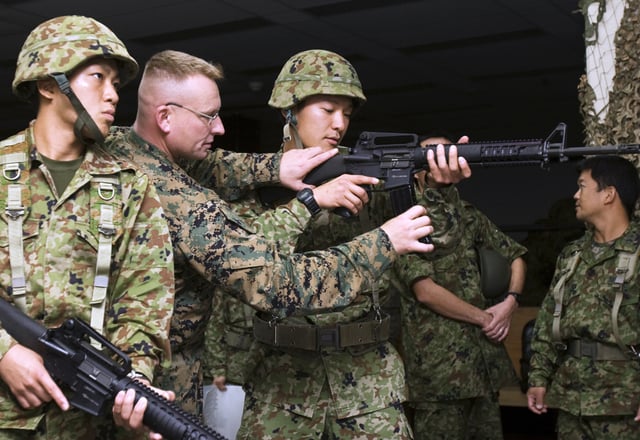
Two JGSDF soldiers training with their M16A4 rifles
The M16A4 is the fourth generation of the M16 series. It is equipped with a removable carrying handle and a full length quad Picatinny rail for mounting optics and other ancillary devices. The FN M16A4, using safe/semi/burst selective fire, became standard issue for the U.S. Marine Corps.
Military issue rifles are also equipped with a Knight's Armament Company M5 RAS hand guard, allowing vertical grips, lasers, tactical lights, and other accessories to be attached, coining the designation M16A4 MWS (or Modular Weapon System) in U.S. Army field manuals.[191]
Colt also produces M16A4 models for international purchases:
R0901 / NSN 1005-01-383-2872 (Safe/Semi/Auto)
R0905 (Safe/Semi/Burst)
A study of significant changes to Marine M16A4 rifles released in February 2015 outlined several new features that could be added from inexpensive and available components. Those features included: a muzzle compensator in place of the flash suppressor to manage recoil and allow for faster follow-on shots, though at the cost of noise and flash signature and potential overpressure in close quarters; a heavier and/or free-floating barrel to increase accuracy from 4.5 MOA (Minute(s) Of Angle) to potentially 2 MOA; changing the reticle on the Rifle Combat Optic from chevron-shaped to the semi-circle with a dot at the center used in the M27 IAR's Squad Day Optic so as not to obscure the target at long distance; using a trigger group with a more consistent pull force, even a reconsideration of the burst capability; and the addition of ambidextrous charging handles and bolt catch releases for easier use with left-handed shooters.[192]
In 2014, Marine units were provided with a limited number of adjustable stocks in place of the traditional fixed stock for their M16A4s to issue to smaller Marines who would have trouble comfortably reaching the trigger when wearing body armor. The adjustable stocks were added as a standard authorized accessory, meaning units can use operations and maintenance funds to purchase more if needed.[193]
The Marine Corps had long maintained the full-length M16 as their standard infantry rifle, but in October 2015 the switch to the M4 carbine was approved as the standard-issue weapon, giving Marine infantrymen a smaller and more compact weapon. Enough M4s are already in the inventory to re-equip all necessary units by September 2016, and M16A4s will be moved to support[25][194] and non-infantry Marines.[195]
Summary of differences
| Colt model no. | Military designation | 20" Barrel w/ bayonet lug | Handguard type | Buttstock type | Pistol grip type | Lower receiver type | Upper receiver type | Rear sight type | Front sight type | Muzzle device | Forward assist? | Case deflector? | Trigger pack |
|---|---|---|---|---|---|---|---|---|---|---|---|---|---|
| 601 | AR-15 | A1 profile (1:14 twist) | Green or brown full-length triangular | Green or brown fixed A1 | A1 | A1 | A1 | A1 | A1 | Duckbill flash suppressor | No | No | Safe/Semi/Full |
| 602 | AR-15 or XM16 | A1 profile (1:12 twist) | Full-length triangular | Fixed A1 | A1 | A1 | A1 | A1 | A1 | Duckbill or three-prong flash suppressor | No | No | Safe/Semi/Full |
| 603 | XM16E1 | A1 profile (1:12 twist) | Full-length triangular | Fixed A1 | A1 | A1 | A1 | A1 | A1 | Three-prong or M16A1 birdcage flash suppressor | Yes | No | Safe/Semi/Full |
| 603 | M16A1 | A1 profile (1:12 twist) | Full-length triangular | Fixed A1 | A1 | A1 | A1 | A1 | A1 | Three-prong or birdcage flash suppressor | Yes | No | Safe/Semi/Full |
| 604 | M16 | A1 profile (1:12 twist) | Full-length triangular | Fixed A1 | A1 | A1 | A1 | A1 | A1 | Three-prong or M16A1-style birdcage flash suppressor | No | No | Safe/Semi/Full |
| 645 | M16A1E1/PIP | A2 profile (1:7 twist) | Full-length ribbed | Fixed A2 | A1 | A1 or A2 | A1 or A2 | A1 or A2 | A2 | M16A1 or M16A2-style birdcage flash suppressor | Yes | Yes or No | Safe/Semi/Full or Safe/Semi/Burst |
| 645 | M16A2 | A2 profile (1:7 twist) | Full-length ribbed | Fixed A2 | A2 | A2 | A2 | A2 | A2 | M16A2-style birdcage flash suppressor | Yes | Yes | Safe/Semi/Burst or Safe/Semi/ Burst/Full |
| 645E | M16A2E1 | A2 profile (1:7 twist) | Full-length ribbed | Fixed A2 | A2 | A2 | Flattop with Colt Rail | Flip-up | Folding | M16A2-style birdcage flash suppressor | Yes | Yes | Safe/Semi/Burst or Safe/Semi/ Burst/Full |
| N/A | M16A2E2 | A2 profile (1:7 twist) | Full-length semi-beavertail w/ HEL guide | Retractable ACR | ACR | A2 | Flattop with Colt rail | None | A2 | ACR muzzle brake | Yes | Yes | Safe/Semi/Burst or Safe/Semi/ Burst/Full |
| 646 | M16A2E3/M16A3 | A2 profile (1:7 twist) | Full-length ribbed | Fixed A2 | A2 | A2 | Flattop with MIL-STD-1913 rail | None | A4 | M16A2-style birdcage flash suppressor | Yes | Yes | Safe/Semi/Full |
| 655 | M16A1 Special High Profile | HBAR profile (1:12 twist) | Full-length triangular | Fixed A1 | A1 | A1 | A1 | A1 | A1 | M16A1-style birdcage flash suppressor | Yes | No | Safe/Semi/Full |
| 656 | M16A1 Special Low Profile | HBAR profile (1:12 twist) | Full-length triangular | Fixed A1 | A1 | A1 | A1 with modified Weaver base | Low Profile A1 | Hooded A1 | M16A1-style birdcage flash suppressor | Yes | No | Safe/Semi/Full |
| 945 | M16A2E4/M16A4 | A2 profile (1:7 twist) | Full-length ribbed or KAC M5 RAS | Fixed A2 | A2 | A2 | Flattop with MIL-STD-1913 rail | None | A4 | M16A2-style birdcage flash suppressor | Yes | Yes | Safe/Semi/Burst |
| Colt model no. | Military designation | 20" Barrel w/ bayonet lug | Handguard type | Buttstock type | Pistol grip type | Lower receiver type | Upper receiver type | Rear sight type | Front sight type | Muzzle device | Forward assist? | Case deflector? | Trigger pack |
Derivatives
Colt Commando (AKA: XM177 & GAU-5)
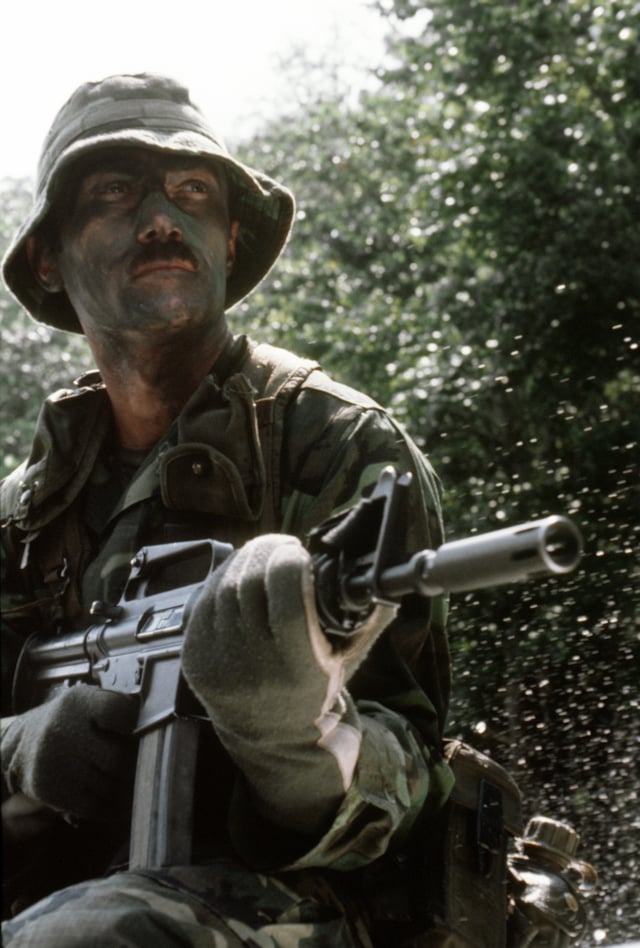
A USAF Combat Control Team member with a GAU-5 carbine and oversized flash suppressor
In Vietnam, some soldiers were issued a carbine version of the M16 named XM177. The XM177 had a shorter 10 in (254 mm) barrel and a telescoping stock, which made it substantially more compact. It also possessed a combination flash hider/sound moderator to reduce problems with muzzle flash and loud report. The Air Force's GAU-5/A (XM177) and the Army's XM177E1 variants differed over the latter's inclusion of a forward assist, although some GAU-5s do have the forward assist. The final Air Force GAU-5/A and Army XM177E2 had an 11.5 in (292 mm) barrel with a longer flash/sound suppressor. The lengthening of the barrel was to support the attachment of Colt's own XM148 40 mm grenade launcher. These versions were also known as the Colt Commando model commonly referenced and marketed as the CAR-15. The variants were issued in limited numbers to special forces, helicopter crews, Air Force pilots, Air Force Security Police Military Working Dog (MWD) handlers, officers, radio operators, artillerymen, and troops other than front line riflemen. Some USAF GAU-5A/As were later equipped with even longer 14.5-inch (370 mm) 1/12 rifled barrels as the two shorter versions were worn out. The 14.5-inch (370 mm) barrel allowed the use of MILES gear and for bayonets to be used with the sub-machine guns (as the Air Force described them). By 1989, the Air Force started to replace the earlier barrels with 1/7 rifled models for use with the M855-round. The weapons were given the redesignation of GUU-5/P.
These were effectively used by the British Special Air Service during the Falklands War.[181]
M4 carbine
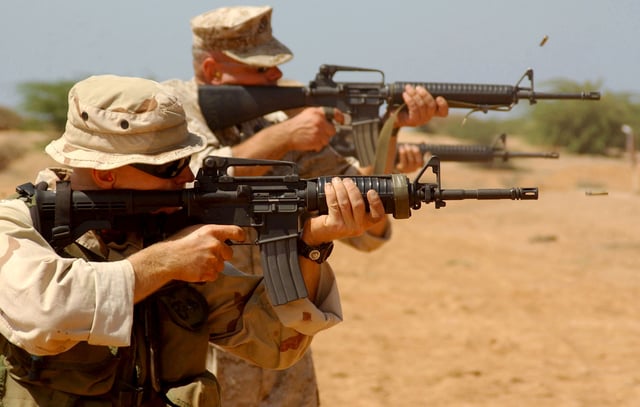
An M4A1 carbine (foreground) and two M16A2s (background) being fired by U.S. Marines during a live fire exercise: though adopted in the 1990s and derived from the M16A2, the M4 carbine was part of a long line of short-barreled AR-15 used in the U.S. military
The M4 carbine was developed from various outgrowths of these designs, including a number of 14.5-inch (368 mm)-barreled A1 style carbines. The XM4 (Colt Model 720) started its trials in 1984, with a barrel of 14.5 inches (370 mm). The weapon became the M4 in 1991. Officially adopted as a replacement for the M3 "Grease Gun" (and the Beretta M9 and M16A2 for select troops) in 1994, it was used with great success in the Balkans and in more recent conflicts, including the Afghanistan and Iraq theaters. The M4 carbine has a three-round burst firing mode, while the M4A1 carbine has a fully automatic firing mode. Both have a Picatinny rail on the upper receiver, allowing the carry handle/rear sight assembly to be replaced with other sighting devices.
M4 Commando
Colt also returned to the original "Commando" idea, with its Model 733, essentially a modernized XM177E2 with many of the features introduced on the M16A2.
Diemaco C7 and C8
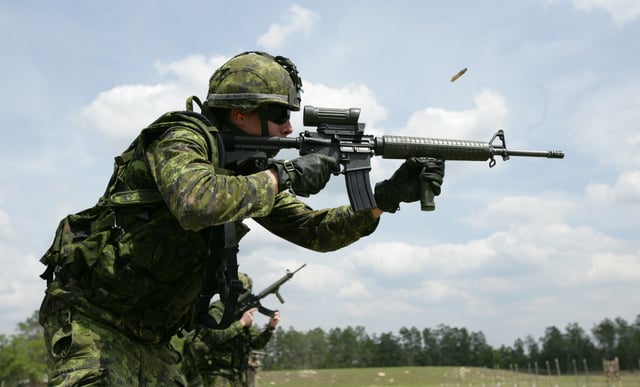
A Canadian soldier fires the current issue C7A2 rifle at the range with a C79A2 sight. This particular example is missing the standard TRIAD mount.
The Diemaco C7 and C8 are updated variants of the M16 developed and used by the Canadian Forces and are now manufactured by Colt Canada. The C7 is a further development of the experimental M16A1E1. Like earlier M16s, it can be fired in either semi-automatic or automatic mode, instead of the burst function selected for the M16A2. The C7 also features the structural strengthening, improved handguards, and longer stock developed for the M16A2. Diemaco changed the trapdoor in the buttstock to make it easier to access and a spacer of 0.5 inches (13 mm) is available to adjust stock length to user preference. The most easily noticeable external difference between American M16A2s and Diemaco C7s is the retention of the A1 style rear sights. Not easily apparent is Diemaco's use of hammer-forged barrels. The Canadians originally desired to use a heavy barrel profile instead.
The C7 has been developed to the C7A1, with a Weaver rail on the upper receiver for a C79 optical sight, and to the C7A2, with different furniture and internal improvements. The Diemaco produced Weaver rail on the original C7A1 variants does not meet the M1913 "Picatinny" standard, leading to some problems with mounting commercial sights. This is easily remedied with minor modification to the upper receiver or the sight itself. Since Diemaco's acquisition by Colt to form Colt Canada, all Canadian produced flattop upper receivers are machined to the M1913 standard.
The C8 is the carbine version of the C7.[196] The C7 and C8 are also used by Hærens Jegerkommando, Marinejegerkommandoen and FSK (Norway), Military of Denmark (all branches), the Royal Netherlands Army and Netherlands Marine Corps as its main infantry weapon. Following trials, variants became the weapon of choice of the British SAS.
Heckler & Koch HK416
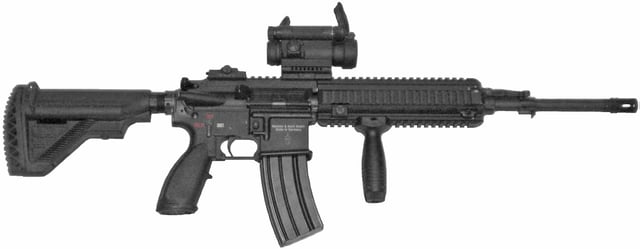
Heckler & Koch HK416
The Heckler & Koch HK416 is an assault rifle designed and manufactured by Heckler & Koch. It is based on the M16, and was originally conceived as an improvement based on the Colt M4 carbine family issued to the U.S. military, with the notable inclusion of an HK-proprietary short-stroke gas piston system derived from the Heckler & Koch G36. The HK416 was used by U.S. Navy SEALs to kill Osama bin Laden.[197][198]
Mk 4 Mod 0
The Mk 4 Mod 0 was a variant of the M16A1 produced for the U.S. Navy SEALs during the Vietnam War and adopted in April 1970. It differed from the basic M16A1 primarily in being optimized for maritime operations and coming equipped with a sound suppressor. Most of the operating parts of the rifle were coated in Kal-Guard, a hole of 0.25 inches (6.4 mm) was drilled through the stock and buffer tube for drainage, and an O-ring was added to the end of the buffer assembly. The weapon could reportedly be carried to the depth of 200 feet (60 m) in water without damage. The initial Mk 2 Mod 0 Blast Suppressor was based on the U.S. Army's Human Engineering Lab's (HEL) M4 noise suppressor. The HEL M4 vented gas directly from the action, requiring a modified bolt carrier. A gas deflector was added to the charging handle to prevent gas from contacting the user. Thus, the HEL M4 suppressor was permanently mounted though it allowed normal semi-automatic and automatic operation. If the HEL M4 suppressor were removed, the weapon would have to be manually loaded after each single shot. On the other hand, the Mk 2 Mod 0 blast suppressor was considered an integral part of the Mk 4 Mod 0 rifle, but it would function normally if the suppressor were removed. The Mk 2 Mod 0 blast suppressor also drained water much more quickly and did not require any modification to the bolt carrier or to the charging handle. In the late 1970s, the Mk 2 Mod 0 blast suppressor was replaced by the Mk 2 blast suppressor made by Knight's Armament Company (KAC). The KAC suppressor can be fully submerged and water will drain out in less than eight seconds. It will operate without degradation even if the rifle is fired at the maximum rate of fire. The U.S. Army replaced the HEL M4 with the much simpler Studies in Operational Negation of Insurgency and Counter-Subversion (SIONICS) MAW-A1 noise and flash suppressor.
US Navy Mk 12 Special Purpose Rifle
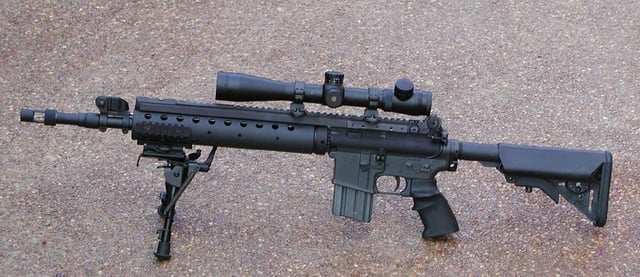
US Navy Mk 12 Special Purpose Rifle
Developed to increase the effective range of soldiers in the designated marksman role, the U.S. Navy developed the Mark 12 Special Purpose Rifle (SPR). Configurations in service vary, but the core of the Mark 12 SPR is an 18" heavy barrel with muzzle brake and free float tube. This tube relieves pressure on the barrel caused by standard handguards and greatly increases the potential accuracy of the system. Also common are higher magnification optics ranging from the 6× power Trijicon ACOG to the Leupold Mark 4 Tactical rifle scopes. Firing Mark 262 Mod 0 ammunition with a 77gr Open tip Match bullet, the system has an official effective range of 600+ meters. However published reports of confirmed kills beyond 800 m from Iraq and Afghanistan are not uncommon.
M231 Firing Port Weapon (FPW)

M231 FPW
The M231 Firing Port Weapon (FPW) is an adapted version of the M16 assault rifle for firing from ports on the M2 Bradley. The infantry's normal M16s are too long for use in a "buttoned up" fighting vehicle, so the FPW was developed to provide a suitable weapon for this role.
Colt Model 655 and 656 "Sniper" variants
With the expanding Vietnam War, Colt developed two rifles of the M16 pattern for evaluation as possible light sniper or designated marksman rifles. The Colt Model 655 M16A1 Special High Profile was essentially a standard A1 rifle with a heavier barrel and a scope bracket that attached to the rifle's carry handle. The Colt Model 656 M16A1 Special Low Profile had a special upper receiver with no carrying handle. Instead, it had a low-profile iron sight adjustable for windage and a Weaver base for mounting a scope, a precursor to the Colt and Picatinny rails. It also had a hooded front iron sight in addition to the heavy barrel. Both rifles came standard with either a Leatherwood/Realist scope 3–9× Adjustable Ranging Telescope. Some of them were fitted with a Sionics noise and flash suppressor. Neither of these rifles were ever standardized.
These weapons can be seen in many ways to be predecessors of the U.S. Army's SDM-R and the USMC's SAM-R weapons.
Others
The Chinese Norinco CQ is an unlicensed derivative of the M16A1 made specifically for export, with the most obvious external differences being in its handguard and revolver-style pistol grip. The ARMADA rifle (a copy of the Norinco CQ) and TRAILBLAZER carbine (a copy of the Norinco CQ Type A) are manufactured by S.A.M. – Shooter's Arms Manufacturing, a.k.a. Shooter's Arms Guns & Ammo Corporation, headquartered in Metro Cebu, Republic of the Philippines. The S-5.56 rifle, a clone of the Type CQ, is manufactured by the Defense Industries Organization of Iran. The rifle itself is offered in two variants: the S-5.56 A1 with a 19.9-inch barrel and 1:12 pitch rifling (1 turn in 305 mm), optimized for the use of the M193 Ball cartridge; and the S-5.56 A3 with a 20-inch barrel and a 1:7 pitch rifling (1 turn in 177, 8 mm), optimized for the use of the SS109 cartridge.[199] The KH-2002 is an Iranian bullpup conversion of the locally produced S-5.56 rifle. Iran intends to replace the standard issue weapon of its armed forces with this rifle. The Terab rifle is a copy of the DIO S-5.56 manufactured by the Military Industry Corporation of Sudan.[200]
The M16S1 is the M16A1 rifle made under license by ST Kinetics in Singapore. It was the standard issue weapon of the Singapore Armed Forces. It is being replaced by the newer SAR 21 in most branches. It is, in the meantime, the standard issue weapon in the reserve forces.
The MSSR rifle developed as an effective, low cost sniper rifle by the Philippine Marine Corps Scout Snipers. The Special Operations Assault Rifle (SOAR) assault carbine was developed by Ferfrans based on the M16 rifle. It is used by the Special Action Force of the Philippine National Police.
Taiwan uses piston-driven M16-based weapons as their standard rifle. These include the T65, T86 and T91 assault rifles.
Ukraine has announced plans for Ukroboronservis and Aeroscraft to produce the M16 WAC47, an accurized M4 variation that uses standard 7.62×39mm AK-47 magazines.[201][202][203]
New Zealand has adopted the Lewis Machine and Tool Company's upgraded version of the M16 system to replace the Steyr AUG. This CQB16 rifle will be fielded in 2017 and is named MARS-L (Modular Ambidextrous Rifle System-Light).
Production and users

Worldwide users of the M16 (former and current)
The M16 is the most commonly manufactured 5.56×45mm rifle in the world. Currently, the M16 is in use by 15 NATO countries and more than 80 countries worldwide. Together, numerous companies in the United States, Canada, and China have produced more than 8,000,000 rifles of all variants. Approximately 90% are still in operation.[14] The M16 replaced both the M14 rifle and M2 carbine as standard infantry rifle of the U.S. armed forces. Although, the M14 continues to see limited service, mostly in sniper, designated marksman, and ceremonial roles.
Users
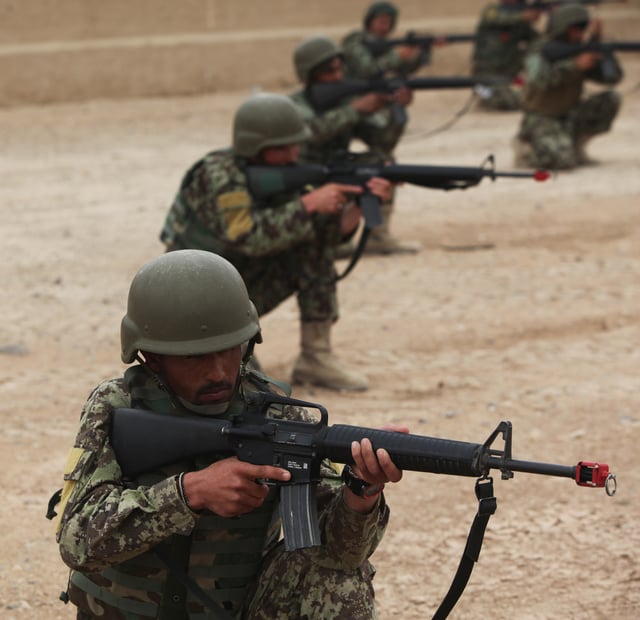
Afghan National Army soldiers with M16A2 rifles
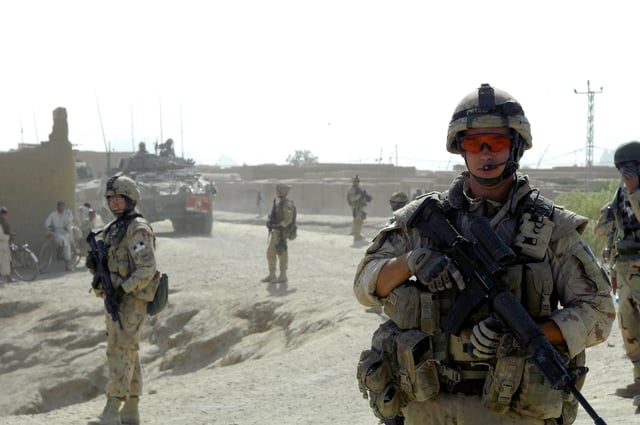
Canadian soldiers patrol Kandahar Afghanistan armed with C7 (M16 type) rifles
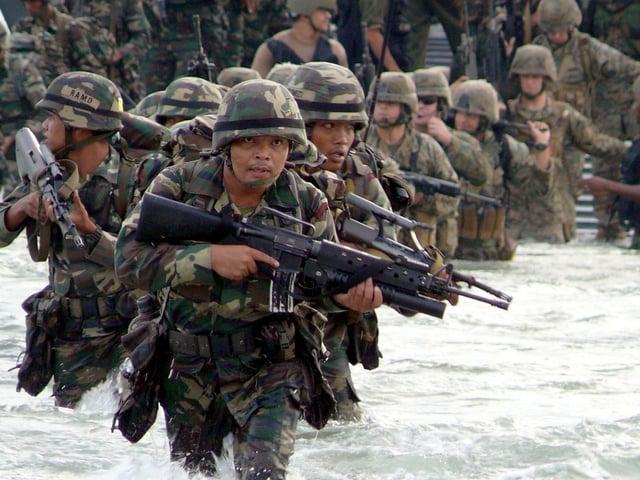
Malaysian Army soldier with an M16A1 equipped with an M203 grenade launcher during a CARAT Malaysia 2008

A Peshmerga soldier with his modified M16A4 rifle
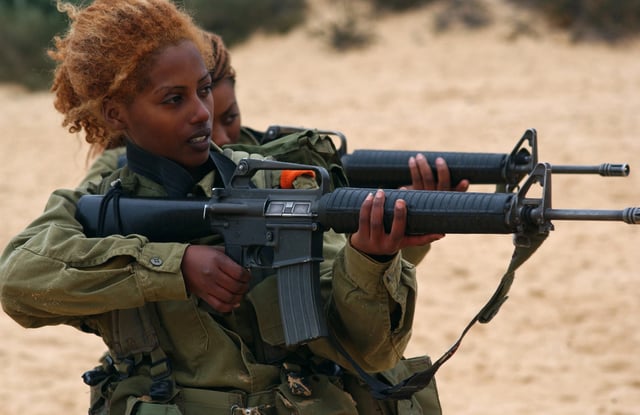
Soldiers of the Israel Defense Forces in training with M16A1 rifles with M16A2 handguards

Monegasque Carabinier with M16 rifle
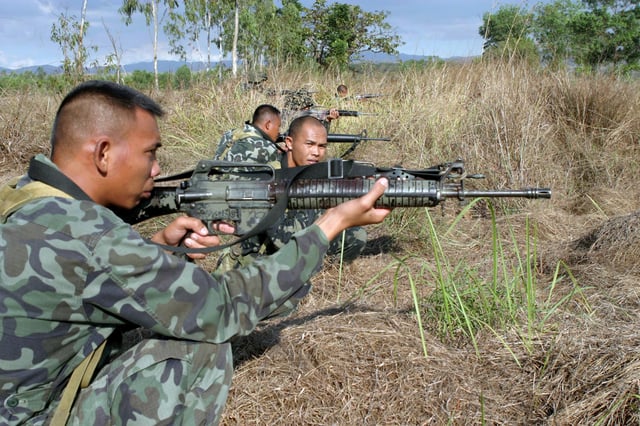
Philippine marines using M16A1 rifles with M16A2 handguard during a military exercise
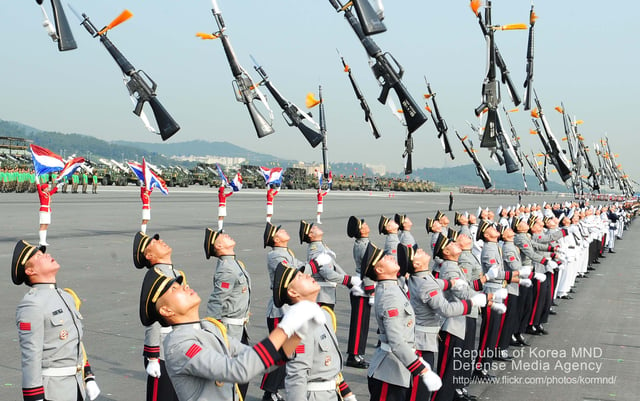
South Korean soldiers toss bayonet mounted M16 rifles into the air at the celebration ceremony for the 65th Anniversary of the South Korean armed forces
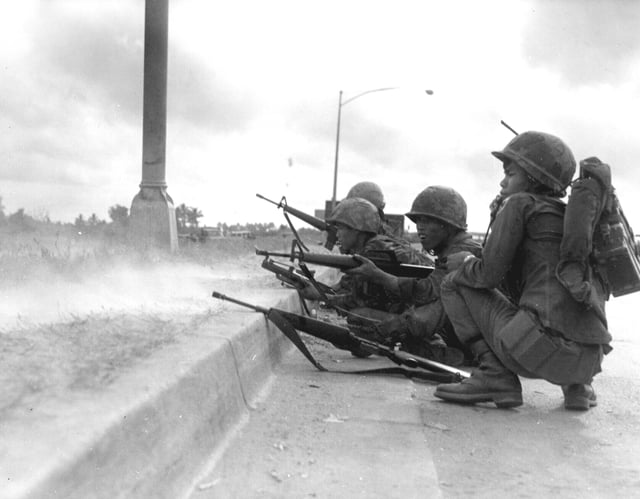
Vietnamese Army (ARVN) Rangers armed with M16s defend Saigon during the Tet Offensive
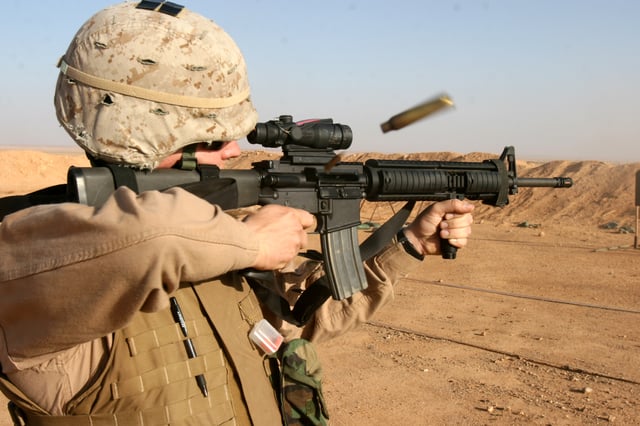
Marine from the US firing an M16A4 equipped with an ACOG
Afghanistan: Standard issue rifle of the Afghan National Army.[204] Colt Canada C7 variants also saw limited service.
Argentina: Special Forces used the M16A1 in the Falklands War and they currently use the M16A2 (by all Armed Forces).[205]
Bangladesh: Used by the military, special forces and counter terrorism units.[209]
Barbados[207]
Brazil: M16A2s used by Brazilian Marine Corps[210]
Brunei[207] M16A2 is used by the Royal Brunei Armed Forces as their main service rifle.
Canada: C7 and C8 variants made by Colt Canada are used by the Canadian Forces.[214]
Central African Republic[7]
Chile[207] M16A1 used by Chilean Marine Corps.
Denmark:[207] C7 and C8 variants made by Colt Canada are used by all branches of the Danish Defence.
East Timor[216] M16A2
Ecuador[207]
El Salvador[207] M16A1/A2/A4[217]
Estonia[218] Ex-U.S. M16A1s.
France: used by counter-terrorism and special operations forces[219][207]
Greece[207] M16A2/A3/A4/M4 is used by the Special Forces of the Hellenic Army ISAF Forces in Afghanistan and the Hellenic Navy.
Guatemala[212] M16A1/M16A2.
Haiti[212]
Honduras[221] M16A1
India[207]
Indonesia[207]
Iraq: Used by Iraqi Army.[223] Kurdistan Region: Used by Peshmerga.[224]
Japan: M16A1 is used by Western Army Infantry Regiment along with Howa Type 89 rifles.[228]
Jordan[207] M16A1/A2.
North Korea: M16A1 (probably unlicensed copies) used by KPA special forces. Used during the Gangneung incident in 1996.[229][230]
South Korea: During the Vietnam War, the U.S. provided 27,000 M16 rifles to the Republic of Korea Armed Forces in Vietnam. Also, 600,000 M16A1s (Colt Model 603K) were manufactured under license by Daewoo Precision Industries with deliveries from 1974 to 1985.[207] KATUSA (Korean Augmentation to the U.S. Army) soldiers who serve in the U.S. Army use the M16A2.
Lithuania: Lithuanian Armed Forces[234]
Malaysia[207] Malaysian Armed Forces, Royal Malaysia Police, Malaysian Maritime Enforcement Agency and RELA Corps.
Mexico:[207] M16A2 is used by the Mexican Marines in the Mexican Drug War.
Morocco[207] M16A1.
Nepal[237] M16A2 and M16A4; captured M16A2 were also used by Maoist rebels of the People's Liberation Army, Nepal during the Nepalese Civil War.[238]
Netherlands: C7 and C8 variants are used by the Military of the Netherlands and LSW is used by Netherlands Marine Corps.[214][239]
Nicaragua[207]
Oman[207]
Pakistan[207] M16A1.
Palestinian Authority: Used by Palestinian Security Forces[240] and various local militant forces.[241][242]
Panama[207] M16A1.
Papua New Guinea[243] M16A2. Bougainville: Used by Bougainville Revolutionary Army. Captured from Papua New Guinea Defence Force.[244]
Peru[207] M16A2.
Philippines: Manufactured under license by Elisco Tool and Manufacturing.[207] M16A1s and M653Ps in use. Supplemented in Special Forces by the M4 carbine.
Poland:The Polish Military Unit GROM used civilian M4 clones, or Bushmaster XM15E2S M4A3 and KAC SR-16 Carbine, as the basic weapon. Since 2008, they have been replaced by the HK416 rifle.[245]
Sierra Leone: 1,000+ M16A1s in use[246]
Singapore: Local variant of the M16A1 (M16S1) manufactured under license by ST Kinetics.[212]
South Africa: Used by Special Forces.[207] Likely received from Moroccan stocks.[247]
Sweden A small number of M16A2s are used by the Swedish Armed Forces for familiarization training[249] (as well as a similar number of AKMs), but they are not issued to combat units. C8 used by Special Forces.
Taiwan[250]
Thailand[207] M16A1/A2/A4.
Turkey[207] M16A1/A2/A4.
United Kingdom: One of first military customers as UK purchased first AR-15s to be used in jungle warfare in Indonesian confrontation.[251] The Colt Canada C8 (L119A1/L119A2) variant is used by Royal Military Police Close Protection Units,[252] the Pathfinder Group, United Kingdom Special Forces[253] and 43 Commando Fleet Protection Group Royal Marines.[254]
Uruguay[207]
Vietnam: Obtained from South Vietnam following Vietnam War[256] Over 946,000 M16s were captured in 1975 alone.[257]
Former users
Australia[258] M16A1 introduced during the Vietnam War and replaced by the F88 Austeyr in 1989.
New Zealand[207] M16; replaced in 1988 by Steyr AUG, which was being replaced with a non-Colt M16 variant in 2016.[259]
Laos: Received from the US government during the Vietnam War and Laotian Civil War.[260]
Rhodesia: M16A1[261]
South Vietnam: 6,000 M16 and 938,000 M16A1, 1966–1975[262]
- DuringThe Troublesin Northern Ireland theProvisional IRAreceived a number of M16s.
See also
Adaptive Combat Rifle
List of Colt AR-15 and M16 rifle variants
Colt 9 mm SMG
Comparison of the AK-47 and M16
Daewoo K2, Republic of Korea Armed Forces (South Korea) assault rifle
List of individual weapons of the U.S. armed forces
M203 40 mm grenade launcher
MSBS Radon
Norinco CQ, M16 clone developed by China
Robinson Arms XCR
Rubber duck (military)
T65 assault rifle, AR-15 variant developed by ROC Army
Winchester LMR
Table of handgun and rifle cartridges
List of assault rifles
